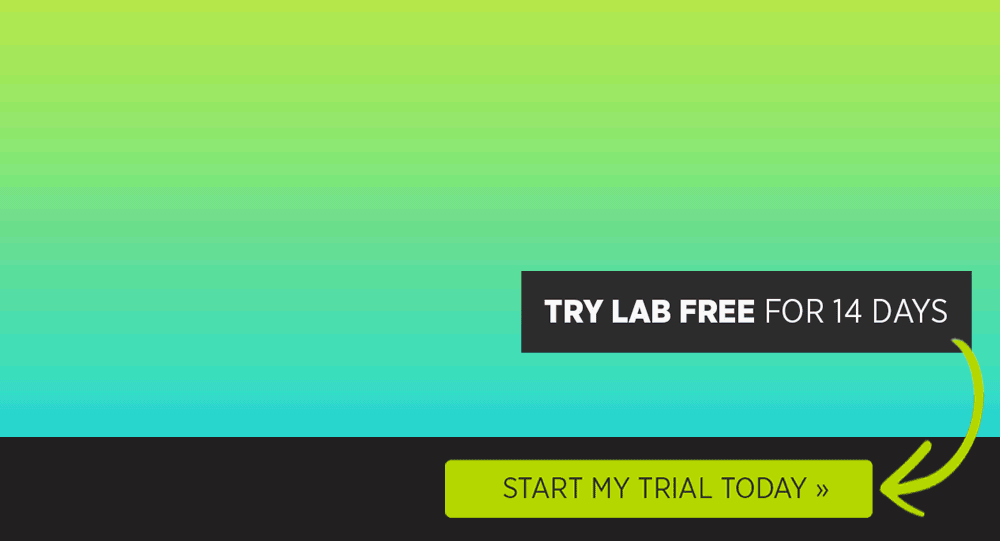Category Archives for Marketing
Ecommerce Website SEO: Unlock 3D Images & Google AR to Increase Sales
Google is taking the user experience to a whole new level by incorporating augmented reality (AR) into its search results making ecommerce website SEO a must. Google AR will offer a more immersive and interactive way to discover and interact with the search results.
One of the ways Google is using AR is through the Google Lens feature, which enables users to point their camera at an object or place, and get information about it. For instance, if you point your camera at a historical building, Google Lens will give you information about it, including its history, location, and reviews.
Another way Google is utilizing AR in search is through its integration of AR in Google Search. This allows users to visualize how products would look in real life, such as furniture, providing them a better idea of how it will fit in their own space. This can help users make more informed purchasing decisions and get a better understanding of the product before buying it.
What is Google Lens
Google Lens is a feature provided by Google that uses image recognition technology to identify and provide information about objects, landmarks, and text in a photo or live camera feed. It is available through the Google Photos app and Google Assistant on Android and iOS devices, and also in the Google search app for iOS.
Users can point their camera at an object or text and Google Lens will analyze the image and provide relevant information, such as the name of a landmark, the ingredients in a dish, or the price of a product. It can also be used to translate text, scan barcodes and QR codes, and even solve math equations.
Google Lens can be useful in various scenarios, such as when you need to know the name of a plant, when you need to translate a menu in a restaurant or when you need to find more information about a product you are looking to buy. It’s designed to be a quick and easy way to get information about the world around you.
3D Images & Google’s AR Feature on SERP
Using 3D images on a website and Google AR feature on SERP (Search Engine Results Page) can help grow your ecommerce website SEO and business in several ways:
Increased customer engagement:
3D images allow customers to visualize and interact with products in a more engaging and immersive way, which can increase customer engagement and ultimately drive more sales. Additionally, Google AR feature allows customers to preview products in their own environment, which can help them make more informed purchasing decisions.
Improved visibility and traffic:
By using 3D images on your website and Google AR feature, you can improve your visibility and increase traffic to your website. When customers search for products on Google, they will be able to see your 3D images in the SERP, which can make your products stand out and increase the chances of customers clicking through to your website which ultimately will improve your ecommerce website SEO.
Increased conversions:
By providing customers with an engaging and immersive shopping experience, you can increase conversions and boost your ecommerce business. Not only that, by using 3D images on your website and Google AR feature can make your products more appealing to customers, which can lead to more sales and increased revenue.
Better Ecommerce SEO:
Using 3D images and Google’s AR feature can also help you improve your ecommerce website SEO by using structured data and other techniques. When you use structured data to describe your 3D images and products, it makes it easier for search engines to understand the content of your images, which can help you rank higher in search results.
Better customer experience:
Using 3D images and Google AR feature can make the customer experience more enjoyable and interactive. Your customers can have a better understanding of the products they are looking at, which can reduce the chances of returning a product and increase customer satisfaction.
In a nutshell, by using 3D images on your website and Google AR feature on SERP, you can provide customers with an engaging and immersive shopping experience, increase conversions, improve visibility and traffic to your website, boost your ecommerce website SEO and business, and provide a better customer experience.
How To Rank Your Products Images In Google’s AR Feature:
There are several strategies that can be effective for ranking products images in Google’s AR feature:
Use high-quality images:
Google prioritizes images that are clear and visually appealing. Make sure the images of your products are high-resolution and accurately depict the product. This should be an integral part of your ecommerce website SEO priorities.
Use structured data:
Google uses structured data to understand the content of an image. By adding structured data to your images, you can provide Google with more information about your products, which can help them rank higher in the AR feature.
Optimize file names and alt tags:
The file names and alt tags of your images should accurately describe the image and include relevant keywords.
Include in your website AR ready:
Google AR feature relies on the web page to understand if that image is AR ready. Having a AR ready website will help you improve your ecommerce SEO which get your site to rank higher in the search.
Optimize for mobile:
Google AR feature is primarily used on mobile devices, so it’s important to optimize your images for mobile to ensure they load quickly and display correctly.
Why should you care about AR? Well, let’s face it. It is important for ecommerce because it allows customers to visualize and interact with products in a more engaging and immersive way, which can increase customer engagement and ultimately drive more sales. Additionally, ecommerce website SEO can help your store to rank higher in the Google AR feature which can also increase your brand’s visibility and lead to more traffic to your website.
How to Make Your Store Ready for AR
To make a website AR ready, you’ll need to take several steps:
Use web technologies that support AR: There are several web technologies that can be used to create AR experiences, such as WebXR, AR.js, and A-Frame. These technologies allow you to create 3D models and animations that can be displayed in a web browser using AR.
Add AR assets to your website: You’ll need to create or obtain 3D models and animations of your products that can be displayed using AR. These assets should be optimized for web and mobile devices, and should be in a format that is compatible with the web technologies you’re using.
Use structured data: To enable the AR feature, you’ll need to add structured data to your website that describes the AR assets and the corresponding products. You can use schema.org vocabulary for this.
Test and optimize: Test your AR experiences on different devices and browsers to ensure they work correctly and provide a good user experience. Optimize your website for performance and accessibility to ensure that the AR experiences load quickly and are accessible to all users.
Use AR browser support: Make sure your website is optimized for AR browsers like 8th Wall, ARKit, ARCore, and WebXR. This will help you to provide a better AR experience to your customers.
Use AR on your product pages: Try to implement AR on your product pages, this way customers can see how the product looks in their own environment before purchasing.
Use AR on your product categories: Use AR on your product categories, this way customers can see how the product looks in their own environment before purchasing and also they can compare with other products.
By following these steps, you can create an AR ready website that provides customers with an engaging and immersive way to interact with your products, ultimately driving more sales and boosting your e-commerce business.
3 AR Tools to Implement AR on Product Pages
8th Wall: 8th Wall is an AR development platform that allows you to create AR experiences for web and mobile devices using web technologies such as A-Frame and AR.js. It has a simple drag-and-drop interface that makes it easy to create AR experiences without coding. It also supports a wide range of devices and browsers.
ARKit & ARCore: ARKit & ARCore are Apple and Google’s native AR development frameworks for iOS and Android respectively, that allow developers to create AR experiences for mobile devices. They can be integrated with Unity and Unreal Engine, making it easy to create high-quality, interactive AR experiences.
Vuforia: Vuforia is an AR development platform that allows you to create AR experiences for mobile devices, using Unity, and it also supports web AR. It includes features such as image and object recognition, and it also supports a wide range of devices and browsers. Additionally, it has a visual editor that makes it easy to create AR experiences without coding.
These are some of the popular tools that can be used to implement AR on product pages, they allow you to create engaging and interactive experiences that can help customers visualize and interact with your products in a more immersive way. It is important to note that depending on the complexity of the project and the resources available, you might need to consider hiring a developer or a specialized agency to implement AR on your product pages.

Gleam.io Review Results: Could You Use it to Grow Your Ecom Business
Gleam.io Review: What is Gleam.io and how it can help you grow your business
Today, the market is flooding with various contests and giveaway platforms, but Gleam stands apart. It is a famous marketing platform used by many leading brands and businesses. Gleam.io interface is intuitive, so learning is easy, and you can quickly get the most out of its valuable features and functionality (I’ll share my findings in this review).
In a nutshell, Gleam is a customer engagement platform that helps you grow your brand visibility. It offers a suite of tools to help you drive traffic, increase conversions, and measure success.
The software can be used to create custom contests, sweepstakes, and giveaways with the help of their templates, widgets, and integrations. You can also use it to engage with your customers by running timed-based competitions on social media or by rewarding them with coupons or discounts on their purchase at your store.
Gleam is also capable of integrating with Facebook Ads Manager to run campaigns on Facebook as well as Google Analytics to measure the ROI of campaigns on various platforms.
I’ve summarized below my thoughts on Gleam.io but you’ll need to read the review to see how you can make use of this platform to increase your users’ engagement with your brand on all the different social platforms.
Do I Recommend Gleam.io?
I’m detailing my findings in this review to help you make a sound decision in selecting the right platform. So, based on my review of the tool, I recommend Gleam to brands who value both simplicity and gamification, need something that does not require a lot of technical involvement, and want something that can be launched in just a few clicks.
Their documentation is extensive and easy to comprehend. In addition, they have given more than 50 ways to use the software platform, including distribution hacks, milestone campaigns, campaign launches, social campaigns, and much more.
Being a MarTech tool, Gleam.io is userfriendly, easy-to-use, and highly productive tool and you should definitely add to your tech stack.
How Do Gleam.io Giveaways Work?
You first start by selecting which type of activation you want to run… Competitions, Rewards, Captures or Galleries. Then you follow below 5 steps:
- Setup: you enter the name of the campaign, starts and ends time, time zone, terms & conditions.
- User Details: Choose how your users log in and what info they must provide. You can select to add an email form in this step to collect more data from users.
- Entries: You select all the different ways users can receive points. You can select between Instagram Entry, Visit a profile, view a post, reshare a tweet, watch a YouTube video, signup to your newsletter and many more options to choose from. See screenshot below.
- Prizes: here you can customize the Prize Area of the Gleam Widget. You can give a detailed description of the prize and add any exceptions for entries (like including or excluding a specific country, age restrictions, etc.)
- Post Entry: in this section you will find the script to embed the Gleam widget on your own landing page. You can also select to have Gleam host the widget for you and you can get access to the specific URL to use for that. You should add your Facebook Pixel and Google Analytics ID in this section for better users’ tracking and Ad retargeting.
Here are the four Apps to build your campaign on Gleam Widget:
Competitions App:
Running a contest can help your company in many ways. It’s a great way to engage your audience, improve your brand awareness, and drive more traffic to your website. Gleam.io has various contest templates to choose from. One of the easiest one you could set-up in under 15 minutes is the Refer-A-Friend contest.
This one can help you grow your reach and build a bigger email list and followers.
Here are some examples of Contests you can run using the Gleam.io platform:

Rewards App:
You can reward your users in different ways, and the Rewards templates cover almost all possible ways to reward the participants and grab the opportunity to collect users information. You can begin with discounts and go for gift cards. Here are some templates:

Capture App:
As its name suggests, this collection of templates is for capturing emails for your next email campaign. You can employ different techniques to compel your prospects to give you their email address willingly! Moreover, it offers integration of a whopping number of providers which is around 25+.

Galleries App:
Suppose you have a treasure of user-generated content that speaks in your favor. In that case, a gallery is an app that gives you an opportunity to display them to your prospects and win their trust.
You can sync the content of the Gallery with the Competition and Rewards apps to get the most out of it. Moreover, it allows you to pull images from hashtags, Facebook pages, and posts. You also can let your users vote on images in the Gallery and share submissions with your audience.

Gleam.io Pros and Cons:
I’m summarizing what I like and what I don’t from my time reviewing Gleam. There are many pros to Gleam.io such as its ease of use, its ability to send out emails automatically to entrants, and the fact that it is free for anyone who wants to try it out.
Pros:
+ Ease of use
+ Integrates with more than 25+ services
+ Sends emails automatically to entrants
+ Offer a free plan to try it out
+ Upgrade, Downgrade or cancel any time
+ Offers various templates
+ Can embed the widget’s script any landing page
+ Can host the widget on Gleam’s URL
+ Randomly select a winner with one click
+ Create a recurring campaigns
+ Include or exclude countries
Cons:
+ Can be costly for solo entrepreneurs
+ The most affordable yearly plan (Hobby Plan) doesn’t offer email capture option.
Is Gleam.io Legit?
Gleam.io is a SaaS business incorporated in Australia and based in Melbourne. Gleam have a fully remote team from all over the world.
The company was founded on April 1st, 2013 and has grown to serve 1M+ businesses of all shapes and sizes worldwide, and surpassed the huge number of 2M sites created inside the platform according to Gleam’s website.
Gleam.io Pricing
Gleam offers three subscription tiers: Pro, Business, and Premium. The screenshot below lists the difference between the three. The differences are mainly the added features such as Linkedin entry, Product Hunt, and Viral share with SMS, Whatsapp, Messenger, and some options for integrations (infusionsoft, hubspot, API, etc.).

Gleam’s pricing structure is as follows:
ProPlan
- Monthly: $97 per site, billed monthly
Yearly: $948 – works out to $79/month
BusinessPlan
- Monthly: $397per site, billed monthly
Yearly: $3,588 billed yearly – works out to $79/month
PremiumPlan
- Monthly: $997 per site, billed monthly
Yearly: $8,988 billed yearly – works out to $749/month
Save up to 24% when subscribing to a Yearly Plan and get double the limits with a yearly plan.
Gleam offers a Free plan which allows you to run unlimited competitions however it comes with limited features & user data.
See Gleam.io prices for each of their full package plans here.
Gleam.io also offers the option to buy a plan for one of their four apps individually (Competitions, Rewards, Galleries, Captures) or choose the full package plan, where you have access to a long list of features and you get access to all four apps. You should check for the price of each App that interests you more.
Should I buy a Subscription to Gleam.io?
I’ve been using Gleam for a few years, would I recommend it to others?
You bet!
Gleam offers a quality tool with a user-friendly interface. I strongly recommend it if you want to create giveaways with various supported platforms to get traffic, grow your business and community, build your email list, or gain momentum and engagement on all social media platforms. The apps are easy to learn and building the widget is easy and requires no technical skill. You can build a Contest and launch it in just 15 to 30 minutes.
You can cancel, upgrade or downgrade your subscription anytime just by just clicking cancel under your Plans tab and it’ll automatically switch you to the free plan on your anniversary date.

9 AI Tools for Successful Marketing Funnels
Introduction to AI Marketing Funnels: Customer engagement has quickly become a widespread use for AI in the retail industry and beyond. With more customers expecting a hyper-personalized, real-time experience, the demand for AI technology in marketing has never been greater.
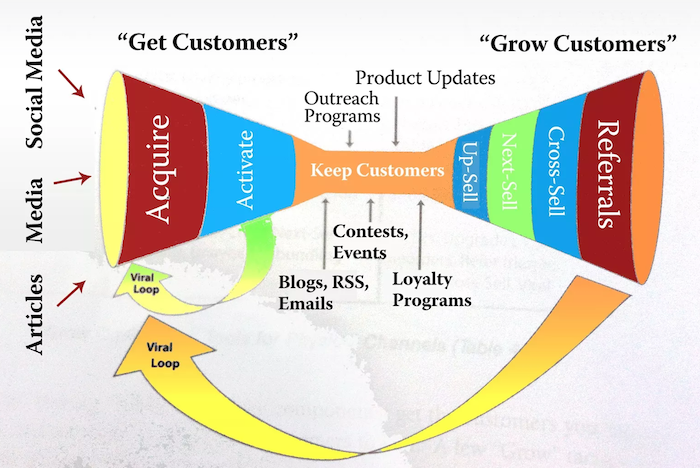
Disclosure: This content is reader-supported, which means if you click on some of our links that we may earn a commission.
It makes sense, then, that so many marketing AI tools and software are targeting the conversion funnel.
From lead generation to lead nurturing to conversion, funnel AI tools help marketers improve their strategy and streamline their processes.
Even small businesses need to adopt AI technology to keep up.
The good news is there are many tools and software platforms available, so you are likely to find one that meets your needs.
9 AI Tools for Successful Marketing Funnels
Here is a deeper look at nine of the top AI tools for successful marketing funnels.
1. Systeme

Systeme offers an all-in-one sales and marketing funnel software that enables you to build and manage your funnel like a boss.
From creating a landing page to teaching an online course to manage your affiliates, the Systeme.io platform provides an array of tools.
The free plan only allows up to 1,000 contacts, so you’ll need to upgrade if you need more.
Systeme also offers three paid plans, including:
- Startup $27/month: Up to 5,000 contacts
- Webinar $47/month: Up to 10,000 contacts
- Enterprise $97/month: Up to 15,000 contacts
If you need more than 15,000 contacts, custom plans start at $147 per month.
If you are just starting out, you will be happy to know that all plans include:
- unlimited emails
- unlimited file storage space
- unlimited membership site members
- no transaction fees (Stripe and PayPal platform fees may apply)
- affiliate programs
- online support
For a truly all-in-one platform, Systeme stands out as both robust and affordable.
Who Should Use Systeme?
Marketers looking to consolidate their suite of marketing tools and processes and rely on one tool.
2. Exceed.ai
According to data from Sales Insights Lab, 50 percent of prospects aren’t a good fit for what you sell.
Instead of using your salespeople to weed out the duds, Exceed’s personalization and lead qualification automation can do it for you in less time.
Use Exceed.ai in the lead nurturing and conversion stages of your marketing funnels.
With Exceed’s top-notch AI technology, engage your leads in human-like conversation.
The platform can even schedule meetings for your reps and bring you that much closer to the sale.
You’ll need to request a quote from Exceed.ai to learn more about the package that fits your budget.
Who Should Use Exceed.ai?
Businesses and organizations that need the greatest help in their sales funnel’s lead nurturing and conversion stages.
3. Saleswhale

All too often, lukewarm leads are left to cool down.
While you may have trouble allocating resources to less-than-enthusiastic leads, Saleswhale has your back.
Saleswhale is a SaaS product that uses AI to identify, engage, and convert neglected leads.
Using automated follow-ups, referral handling, and interest qualification, Saleswhale’s AI assistants offer a best-in-class experience for you and your leads.
With the free plan, you can begin to nurture and convert up to 200 leads per month.
For additional leads and active email campaigns, paid plans include:
- Starter $495/month: Up to 500 leads/month, one active campaign
- Plus $1,495/month: Up to 2,500 leads/month, three active campaigns
- Professional $2,495/month: Up to 5,000 leads/month, 10 active campaigns
Who Should Use Saleswhale?
Companies strong in lead generation, but who need assistance in lead nurturing and conversion.
4. Appier

Similar to Systeme, Appier is an all-in-one sales tool with a full suite of AI services.
This SaaS can help with prospecting to transactions with its robust data science platform.
Where Appier excels is in cross-advertising solutions.
Using AI, Appier can effectively segment your audience to drive maximum lead conversions.
You no longer need to create campaign after campaign hoping to hit the mark, as Appier will do the dirty work for you.
Appier’s pricing is not available on their website, so you’ll need to reach out to learn more about their tools and their potential fit with your business.
Who Should Use Appier?
Companies looking for a comprehensive suite of AI-powered marketing tools.
5. ClickFunnels

If you are looking for an end-to-end sales funnel solution, then consider ClickFunnels.
Utilizing AI sales models and neural sales data, ClickFunnels aims to improve the marketing experience for businesses of all sizes.
ClickFunnels enables you to easily create funnels, build websites, and manage affiliates.
This means you can collect, nurture, and convert leads using just one platform.
With more than 100,000 entrepreneurs using or having used the platform, it has undoubtedly made a name for itself in the industry.
While there are no free plans available, there are plans for almost any business’ budget.
These include:
- Basic $97/month: 20 funnels, 100 pages, three payment gateways, and three domains
- Platinum $297/month: Unlimited funnels, unlimited pages, nine payment gateways, and nine domains
- Two Comma Club $2,497/month: Unlimited funnels, unlimited pages, 27 payment gateways, and 27 domains
All plans come with chat support and video training.
Who Should Use ClickFunnels?
Companies who want an all-in-one solution that offers hand-holding and easy-to-use templates.
6. Data Studio

Previously known as BrightFunnel, Data Studio by Terminus is a funnel reporting tool that connects marketing platforms to deliver beautiful, insightful analytics.
When your sales funnel is fully implemented, it is crucial to evaluate it regularly.
While many marketing tools and services provide their own data and reports, they may not be as robust as you need.
With Data Studio, you can create custom reports for marketers, executives, and stakeholders.
Pricing is not readily available on the website, but you can schedule a demo to learn more about the platform.
Who Should Use Data Studio?
Marketing teams need a cohesive analytics and insights platform to bring their sales to funnel data to life.
7. Akkio
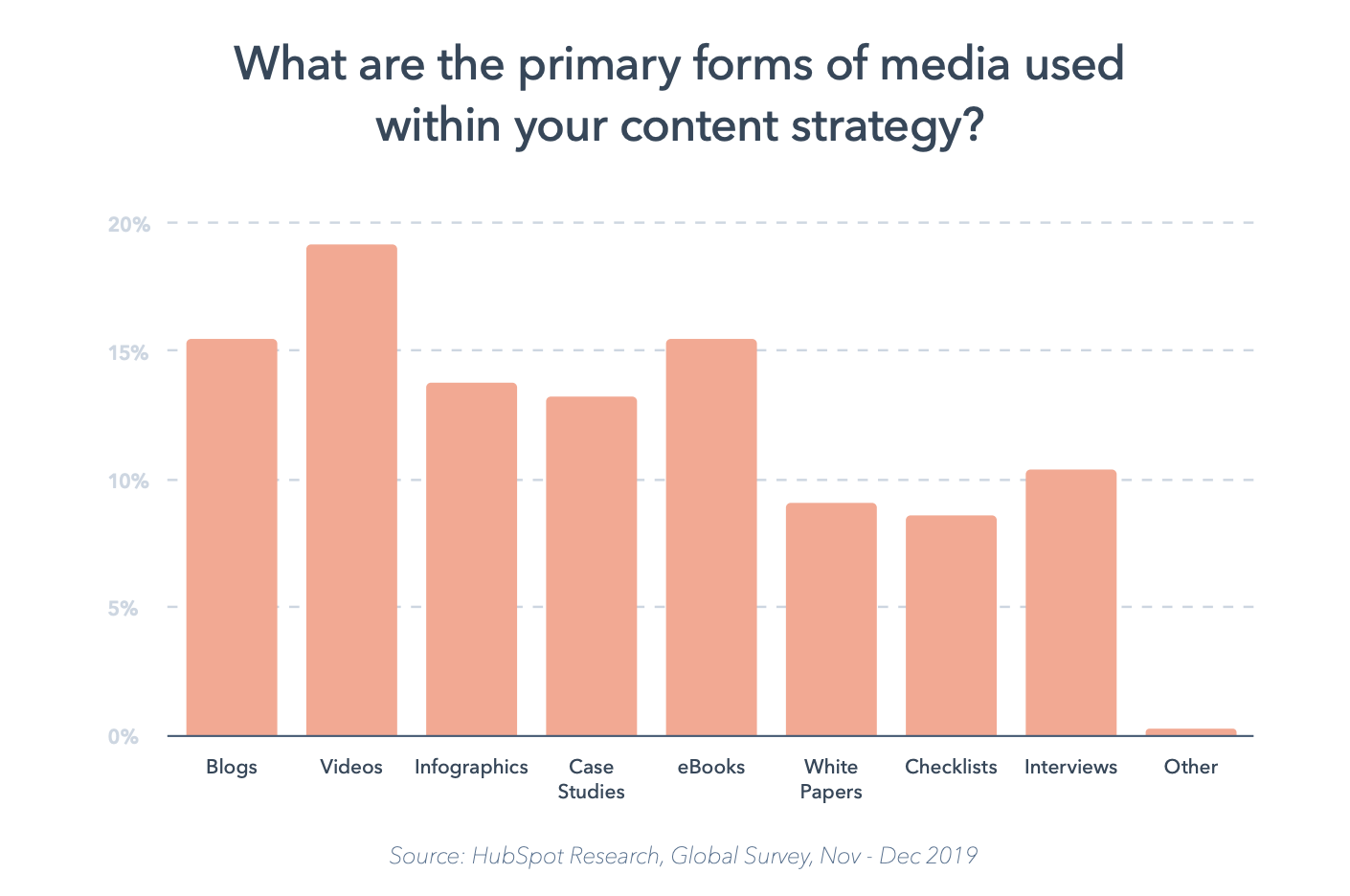
According to HubSpot, the top priority for marketers is generating leads.
However, as any marketer can tell you, not all leads are created equal.
You can spend your time manually poring over the data to determine your best path forward, or you can let Akkio take the reins.
Akkio is an AI marketing platform with tools to support every stage of the funnel.
Where it excels, however, is in its augmented lead scoring and churn reduction technology.
Using data-driven insights, Akkio aims to narrow in on the leads with the greatest chance of a conversion.
For as low as $50 per month, billed annually, you can give Akkio a try with very little risk.
The features included in all plans are:
- unlimited users
- unlimited data
- unlimited flows and deployments
- integrations and API
- model reports
Who Should Use Akkio?
Companies looking for a scalable, data-driven solution.
8. Bant.io
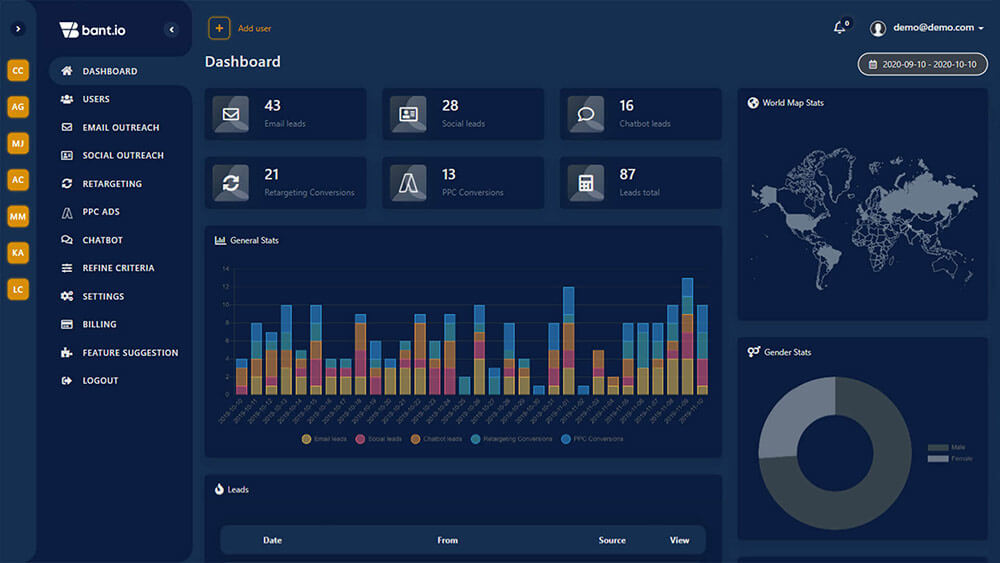
If you are hurting for qualified leads, you should know you’re not alone.
According to HubSpot, 61 percent of marketers consider a lead generation to be their top challenge.
The good news is there are marketing AI tools, like Bant.io, that can help.
Bant.io offers an impressive array of lead generation tools and services.
These run the gamut, including:
- social outreach
- pay per click ads
- retargeting ads
- sales chatbot
Unlike many one-size-fits-all options, Bant.io plans are customizable to meet your business’s needs. Just add the modules you need and leave the rest.
The modules include:
- Email Outreach: $795/month
- Social Outreach: $495/month
- Retargeting Ads: $395/month
- PPC Ads: $395/month
- Sales Chatbot: $95/month
With Bant.io’s automated services at your fingertips, you will soon find yourself buried in qualified leads who are ready to take the next step.
Who Should Use Bant.io?
Marketers who favor a piecemeal approach to lead generation.
9. Funnel.io
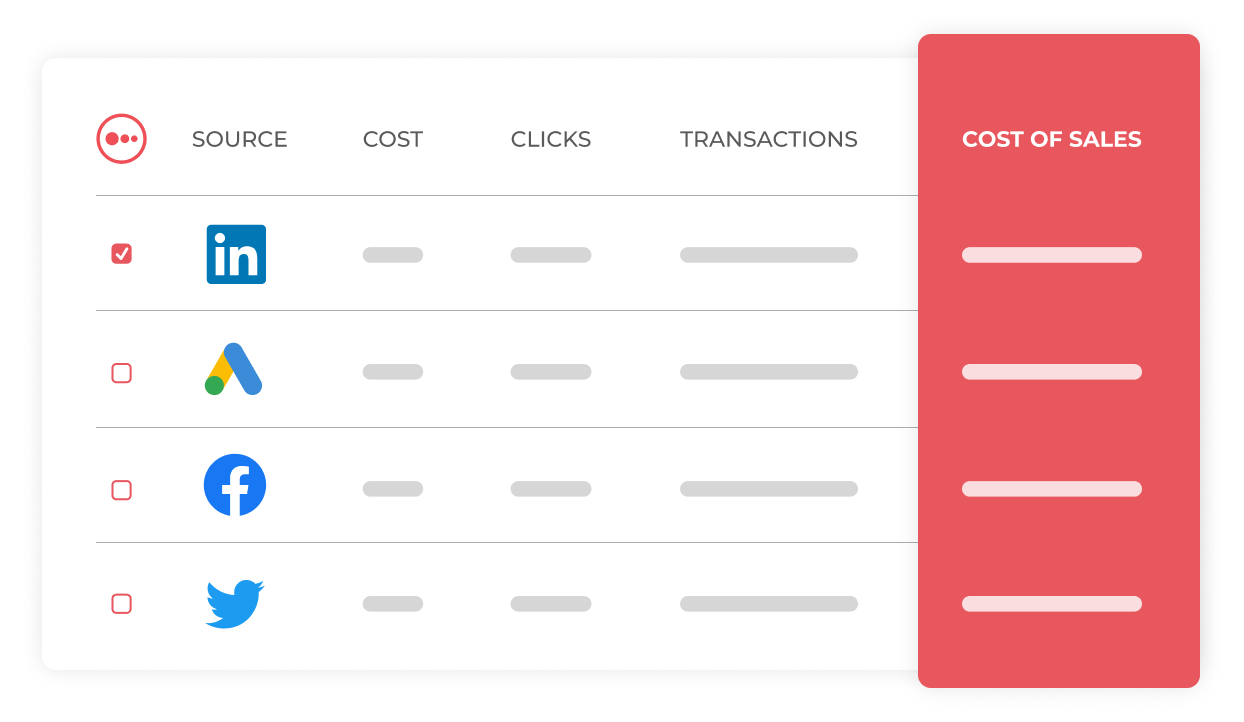
It’s not enough to have a marketing funnel in place.
You must evaluate every step of your funnel on a regular basis.
While most funnel tools will have their own reporting, they may not always present you with the big picture.
That’s where a reporting tool like Funnel.io comes in.
With 500+ data connections available, Funnel.io makes it easy to build reports that touch on all areas of your business.
Can’t find the data source you need?
The team at Funnel.io will work with you to get it added to their platform.
There are a variety of plans available, including:
- Essentials $399/month: Connects to 260 platforms, five seats, email support
- Plus $999/month: Connects to 500+ platforms, unlimited seats, email and chat support
- Enterprise $1,999/month: Connects to 500+ platforms, unlimited seats, priority email and chat support and a Customer Success Partner
All plans are billed annually.
Who Should Use Funnel.io?
Marketers or agencies looking for a comprehensive and collaborative reporting platform.
Frequently Asked Questions About Marketing Funnel AI Tools
Do you have questions about funnel AI tools?
Take a look at the most frequently asked questions below.
What Role Will AI Play in Marketing in the Future?
With increased expectations from both B2C and B2B customers, there will continue to be a need for AI tools in marketing and sales.
This isn’t just within the retail industry, but healthcare, food services, technology, and beyond.
What Should I Look for in a Sales Funnel AI Tool?
First, you want to find a tool specializing in the sales funnel stage your business most needs help with (lead generation, lead nurturing, conversion, or all stages).
Then consider how easily the tools available fit into your daily workflow so you can choose the right one for your business.
When Should I Consider an All-in-One Solution?
Whether you are just getting started or you would like to consolidate your marketing efforts, an all-in-one solution can be a smart option.
The benefit is having all of your data in one place which can improve your ability to use it.
What Types of Businesses Benefit Most From Sales Funnel AI Tools?
With the explosive growth of marketing funnel tools utilizing AI technology, there are tools available for just about any budget.
From small businesses to large corporations and marketing firms, just about any business can benefit from AI-driven sales funnel tools.
AI Tools for Successful Marketing Funnels: Conclusion
Marketing automation and AI are here to stay.
This is why companies big and small need to make the shift to using marketing AI tools sooner rather than later.
There is no one-size-fits-all approach to marketing automation.
Luckily for marketers, there are plenty of tools, platforms, and software to choose from.
Whether you choose an all-in-one solution or a platform that specializes in just one step of the funnel will depend on your needs.
Whatever you choose, just know you are taking an important step in future-proofing your digital marketing processes.
Which of the above marketing funnel AI tools would be a beneficial addition to your business?
Source: neilpatel.com

Everything You Should Know to Create a Useful Competitor Report
Analyzing and monitoring your competition is fundamental to any business’s success.
So what should a good competitive report include and how to take it from research to action?

Why Does My Business Need a Competitive Report?
There are many reasons why a business may need a competitive report, and all of these are valid:
- To better understand your target audience by researching how they find and engage with your more established competitor
- For market research: Understand what is currently available on the market and where your business fits inTo get an estimate of your future marketing budget
- To identify effective marketing tactics, etc.
Business owners that claim they don’t need a competitive report because they already know everything are clearly missing out. Competitive research is much more than copying your more successful competitor’s marketing tactics.
Actually, it is not at all about that because copying would never bring you ahead.
Competitive research is about understanding your target market and distinguishing your unique value proposition and consequently your unique marketing strategy to conquer it.
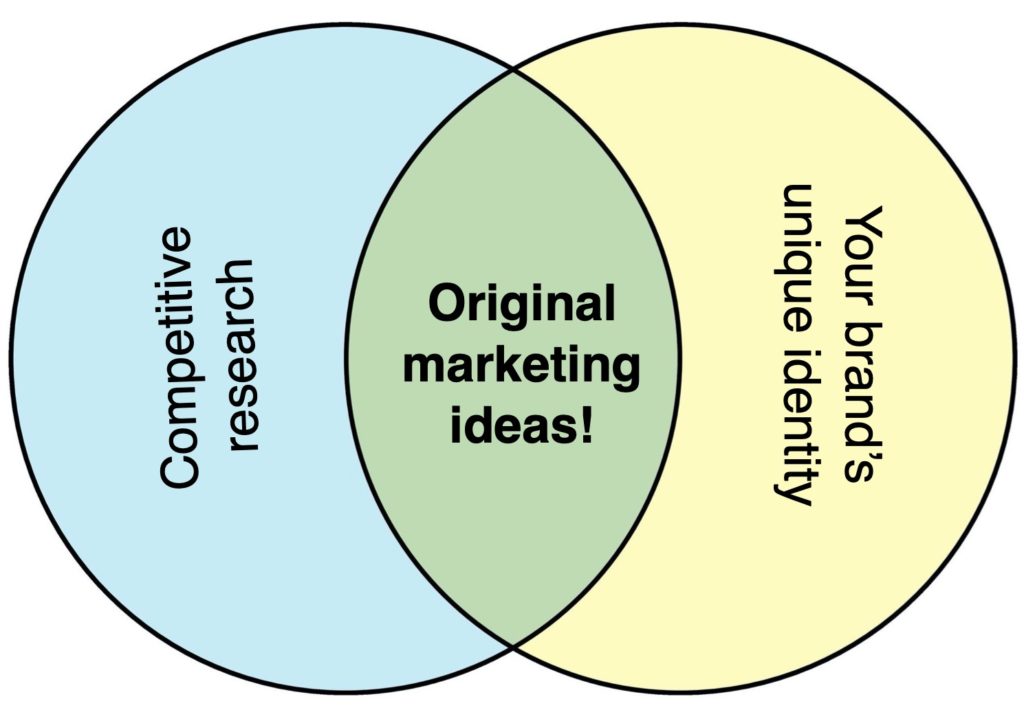
So what should a solid competitive report include?
Competitive Benchmarking
Competitive benchmarking means collecting the performance data of your competitors and comparing it to your business. It is used to measure and monitor your business’s performance against its competitors.
You can choose your own performance indicators to track and compare. These may include:
- Public traffic data (from tools like Ahrefs, Alexa, and Similar Web)
- Organic rankings
- Brand awareness and sentiment (based on brand mentions), etc.
This section in your report is going to always evolve but it is also fundamental because your whole competitive analysis will evolve based on KPIs you will identify as the most important for you.
Basic Overview of Competition
There are fundamental KPIs you are going to focus on and there are secondary metrics that will help you identify competitors to keep an eye on.
This section is about the latter. This basic section helps you look at your competitors’ secondary metrics at a glance to identify if there’s a definitive pattern to look deeper into:
- Backlinks
- Organic traffic
- Social media followers
- Social media engagement, etc.
- Tools like Ahrefs, Keyhole, and Similarweb will help you collect all the necessary data.
Detailed Dive into Organic Search Engine Optimization Tactics
Look at some key search engine optimization tactics your competitors are using:
- Which keywords are they focusing on?
- How are they optimizing their title tags and meta descriptions?
- Are they optimizing their old content and how often?
- What does their site architecture look like?
- How are they organizing their main navigation?
- What’s their internal linking strategy?
- What are their most successful pages (i.e. those that rank for the most competitive search queries)?
- What’s their semantic optimization strategy?
Try running a few of the most important pages through a tool called Text Optimizer to determine whether your competitors are doing a good job optimizing for search intent:
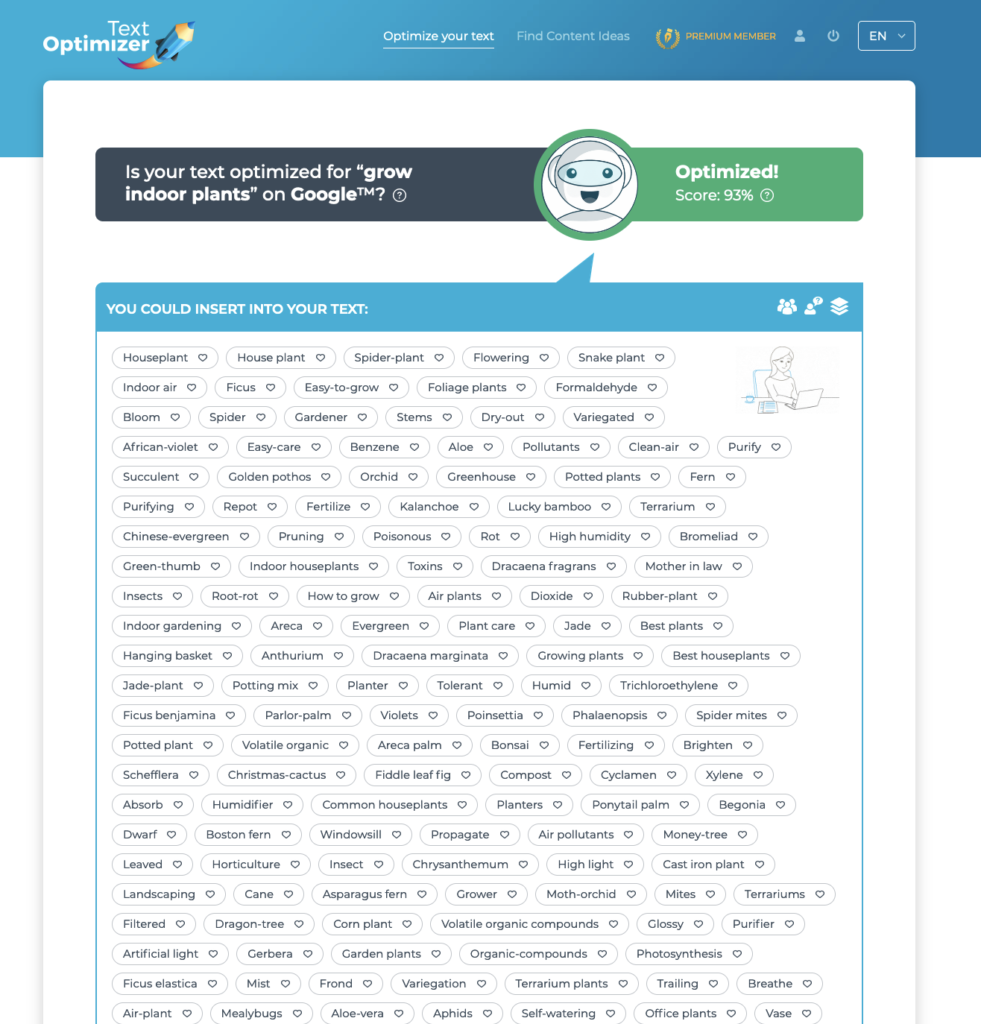
One of the most actionable steps here is to look at Content Gaps, i.e. researching which keywords your competitors are ranking but your site is not. This is a great way to expand your content strategy to include new keywords. Ahrefs provides this analysis, so it is both easy and effective:
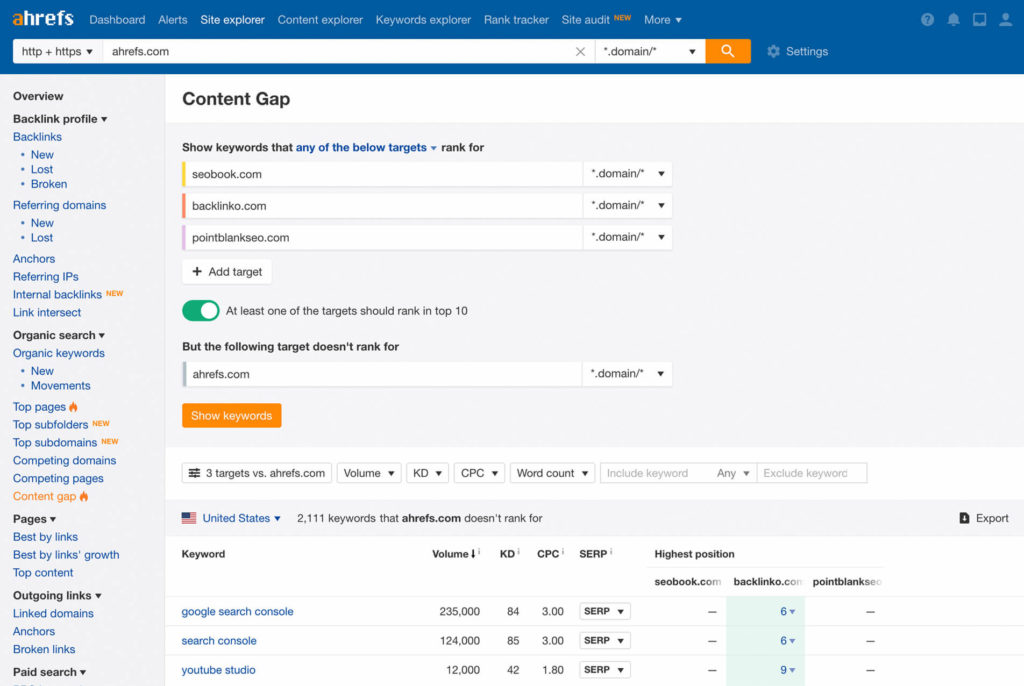
Competitors’ Backlink Research
Backlink research is important for many reasons but doesn’t just use it in an effort to “steal” some of those tactics or claim some of those links. Look at a bigger picture:
- Who are your competitors’ promoters (i.e. people who link to them) and how did your competitors win their hearts?
- Which PR tactics seemed to work best for your competitors and why?
- How are they utilizing content to generate backlinks?
The purpose of competitive backlink research is to understand what works for niche publishers and how you can build your own long-term relationships with them to outmatch your competitors in the long run.
There are quite a few backlink checking tools that would help you create this report.
Social Media Growth and Engagement
The first part of this section is, again, an overview giving you an idea on who to research further. Create a quick chart summarizing your competitors’ active social media channels, number of followers and friends, and their overall activity.
Keyhole can help you with that section:

Social Media Tactics to Take a Note of
Here I suggest highlighting some creative tactics your competitors are using on social media. Forget about numbers: Highlight what you found ingenious even if that didn’t yield obvious great results. Make lots of screenshots!
- Did your competitor use humor when replying to a customer?
- Did you like the video they uploaded for a holiday?
- Was their sponsored update particularly creative and attention-grabbing?
- Did they manage to get attention from a niche influencer?
- Did you like the idea behind their social media contest or poll?
This section is supposed to inspire your social media team. Discourage them from copying anything your competitor did on social media (this could quickly turn into a reputation crisis). Instead, let this section be a conversation starter for your team to come up with their own ideas.
Conclusion
There are very few business ideas or models that have no competition. If you have found one: Good for you! For the rest of us, a competitive report is a key to marketing success, especially if you make it actionable and use it as a starting point for your own brainstorming meetings.
Distinguish tactics to discuss and use unified communications to come up with the ideas to improve and expand those tactics, as well as find unique angles and maintain your brand identity. Good luck!
The post Everything You Should Know to Create a Useful Competitor Report appeared first on DigitalMarketer.
Source: digitalmarketer.com

Website Redesign SEO Checklist: Tips to Avoid Big Drops in Your Rankings
If your website is no longer reaching its potential, then it might be time for a redesign. One case study found leads improved by 314 percent following a website redesign and SEO campaign.
Although redesigns can be expensive, it’s a better option than bleeding money year after year with an inefficient website.
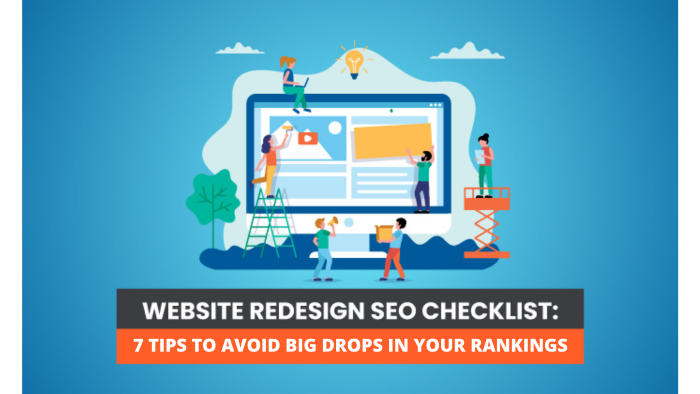
When redesigning your site, it’s important you avoid the pitfalls that can severely hamper your SEO. To help you do this, here’s my website redesign SEO checklist.
What Is a Website Redesign?
A website redesign involves large-scale changes to your website. During a redesign, elements of your code, content, structure, and visuals may change dramatically, giving your site a completely fresh look.
This is a natural—and important—part of a website’s development. As much as 50 percent of consumers believe website design is an important part of a company’s brand.
Even if you had the greatest website in the world back in 2001, it would be looking very out of place today if you didn’t make any large changes to it. Here’s what an Amazon web page looked like back in 2001.
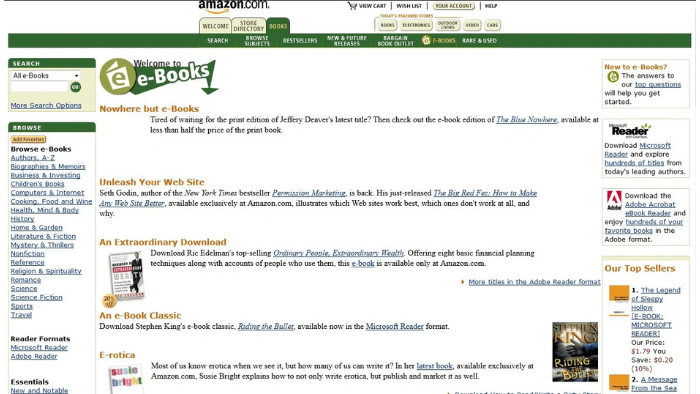
Design best practices change, technology changes and your target audience’s expectations change; your website needs to change to keep up.
Accessibility plays a big part as well. When visiting a site for the first time, 38 percent of people will look at the page’s layout or navigational links.
Sometimes these will mean making smaller changes as part of a website refresh, but occasionally, you’ll need to make more large-scale changes in the form of a full-scale website redesign. Either way, you need to make sure you are following current best practices so your website redesign SEO isn’t affected.
Benefits of a Website Redesign
Website redesigns aren’t without risk (especially for website redesign SEO), but when done well, they offer significant upside. They can:
- improve SEO and site performance
- simplify the user experience
- focus your content strategy
- give your site a facelift
- offer faster load speeds
- provide up to date security
The most obvious benefit is since your website serves as a modern-day shop front, you want to make it attractive.
If a physical store has a broken sign, poor lighting, and a dingy interior, it’s going to struggle to appeal to people. It’s the same for a website; if it looks tired and out of date, your visitors are going to wonder if your business is tiring and out of date as well.
A website redesign is about more than just a facelift.
It also gives you an opportunity to change the fundamental structure of your website and make it easier for visitors to navigate. You want to start with the right approach since even doing a simple redesign with basic features can take an average of two months to complete.
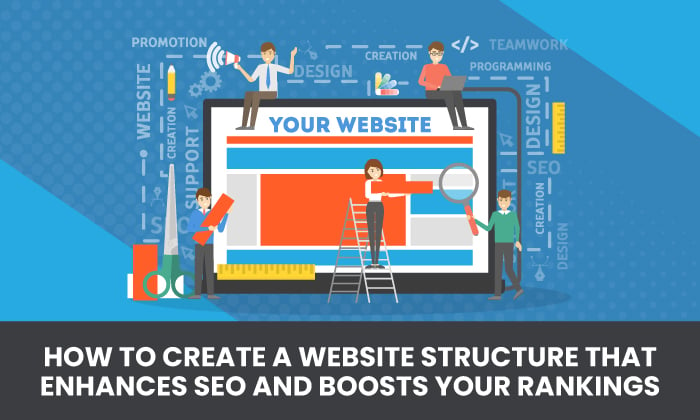
Businesses change over time, and as their websites evolve and grow naturally, the structure of the website can become messy. You add new content categories, move things around on your nav bar, switch parent and child pages, and so on.
A simple rule when it comes to design and UX is that complicated design is rarely good. You want to make it as simple as possible for your visitors (and bots) to navigate your site and find what they’re looking for. A website redesign is a great opportunity to do this.
This is an ideal time to evaluate your site, decide on your goals, and create a redesign strategy that can help you achieve them.
When Are Website Redesigns Necessary?
According to a 2020 survey, here are the top reasons for a website redesign:
low conversion rates (80.8 percent)high bounce rates (65 percent)needs better UX (61 percent)not responsive on all devices (53.8 percent)outdated website (38.5 percent)not SEO-friendly (23.1 percent)
It can be tricky to know when a website redesign is necessary. Chances are, you’re investing a good chunk of money in your redesign, so you want to get the timing right.
The thing to remember is user experience is absolutely essential in digital marketing. It’s going to show in almost every metric and, ultimately, it’s going to have an impact on your bottom line.
The metric closest to most website owners’ hearts is conversion rate. This can be a big sign that it’s time for a website redesign.

Conversion rates fluctuate, but if yours is in a downward spiral, then it might be time to consider a website redesign. They are also different depending on your industry.
For example, if your website is part of the Real Estate or Home Improvement industries, your conversion rates will be around 7 percent. However, if you are part of the Media & Entertainment industry, it might be closer to 18 percent.
One of the best ways to know if it’s time to make changes to your website is to use it from the point of view of your visitors. Imagine you’re visiting your site for the very first time and ask yourself these simple questions:
- Does the branding seem on-point?
- Do pages load quickly?
- Is your site laid out in a logical way that’s easy to navigate?
- Are your pages optimized for mobile?
- Is it difficult to find the information you’re looking for?
- Is your customer journey streamlined enough?
Compare your website to your competitors and see how you stack up. If you find your site is good in certain areas but missing a few details in others, a website refresh might be the answer. If there are lots of things holding you back on the other hand, then it’s probably time for a full website redesign.
Website Redesign SEO Considerations Before Getting Started
The top reason visitors leave a website is due to slow loading times—88.6 percent of survey respondents in a 2020 survey affirmed this. Page speed, directly and indirectly, affects SEO.
This is just one reason to be vigilant about multiple factors that can affect website redesign SEO— planning a redesign isn’t something that should be taken lightly. The rewards are great when things go right, but can be a nightmare if things do go wrong.
The first step is to consider your goals.
What do you want out of your website redesign? What realistic targets can you set?
To set the right goals, you’ve got to have some benchmarks for your current website performance. Make use of your analytics and come up with SMART goals.

Once you’ve come up with your goals, then you can begin thinking about a timeline. The important part here is to be realistic. As you’ll see in the website redesign SEO checklist, there are a lot of steps to consider, so make sure you give yourself enough time to do a great job.
Then you’ll need to put together the right team to carry out your vision. You’ll need talented designers, developers, and content managers to ensure things run smoothly, but don’t underestimate one key element: communication.
Your team needs to be working together and communication is extremely important.
Website Redesign SEO Checklist
This website redesign SEO checklist will help you stay organized throughout the entire process and make sure you don’t miss anything important.
1. Audit Your Existing Content
Content powers many websites’ organic presence. Eighty-two percent of marketers actively use content marketing, and many successful businesses are built off of it.
A website redesign SEO process has the potential to take your content efforts to the next level, but first, you’ve got to have a good picture of where it’s at.
First, use a tool like Screaming Frog to pull data on all URLs included in your website.
Next, use your analytics and Ubersuggest to perform a complete content audit to determine your most important pages, see which pages are irrelevant or not needed anymore, and which should be redirected or combined with other pages.
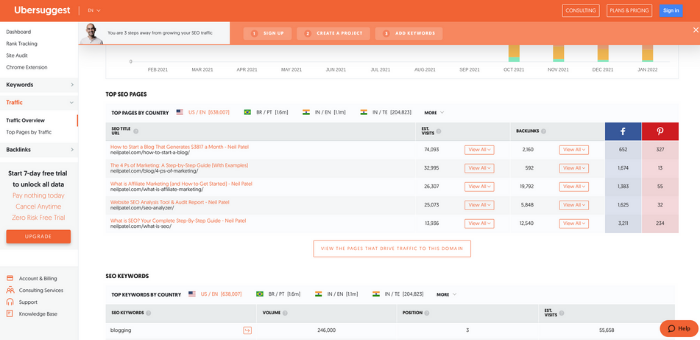
Follow these steps and you should have a clear idea of which pages (and keywords) are most important. Look at your traffic stats, rankings, and conversion goals to see where other improvements can be made.
2. Update Information Architecture
Over 60 percent of users report leaving a website due to bad navigation. Although website navigation and information architecture (IA) are different, your IA should inform how your site navigation is structured.
Information architecture is about how you organize information in your sitemap. Navigation is how you organize your website.

As mentioned earlier, 38 percent of people will look at a site’s layout and navigational links on their first visit.
Let’s use this example post: “How to Scale Mt Everest.”
If people have to find it by navigating through a tips page, then climbing strategies, then Asian peaks, before finally clicking Mt Everest, it’s going to be nearly impossible to find.

Wouldn’t it be a lot easier if the process could simply be Peaks > Mt Everest > How to Scale Mt Everest?
How you organize information all depends on what your website is about, why people come to your site, and what information is most valuable.
To update your IA:
- Start by creating a map of your current structure.
- Do competitor analysis to see how your competition organizes their websites.
- Use a tool like Hotjar to see where users click and how they interact with your site.
- Using note cards or post-its, write down the main categories for your site.
- Next, write your subheadings based on the data you’ve collected.
- Write down the URLs for pages you keep, and organize them under the subheadings.
- Create a new sitemap based on what you created.
3. Carefully Map URL Redirects
In a Semrush study that analyzed 150,000 websites, 42.5 percent of the websites considered had broken internal links.
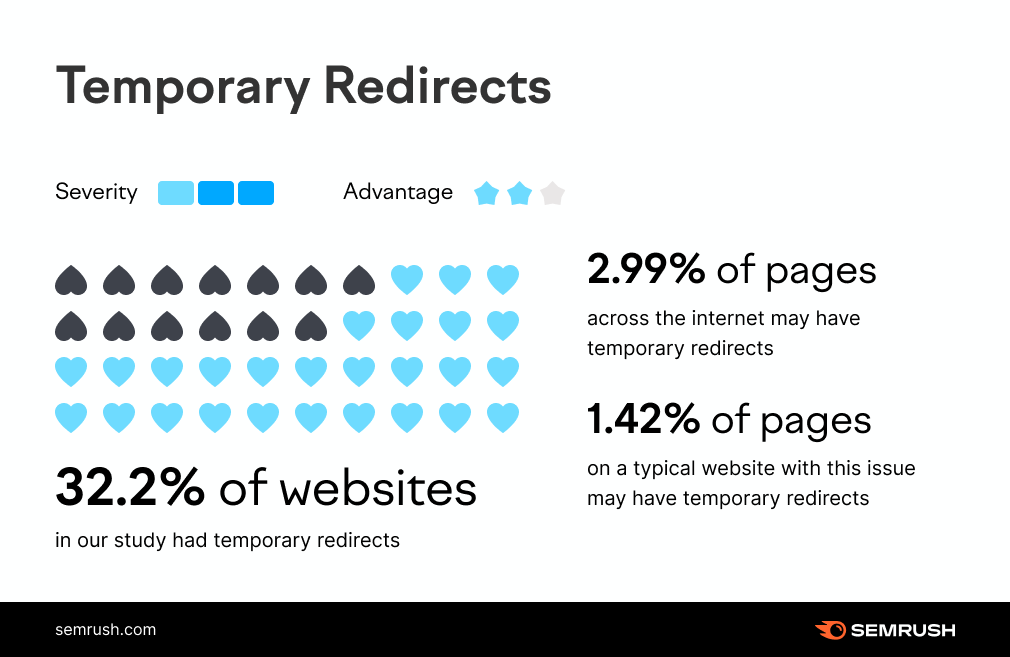
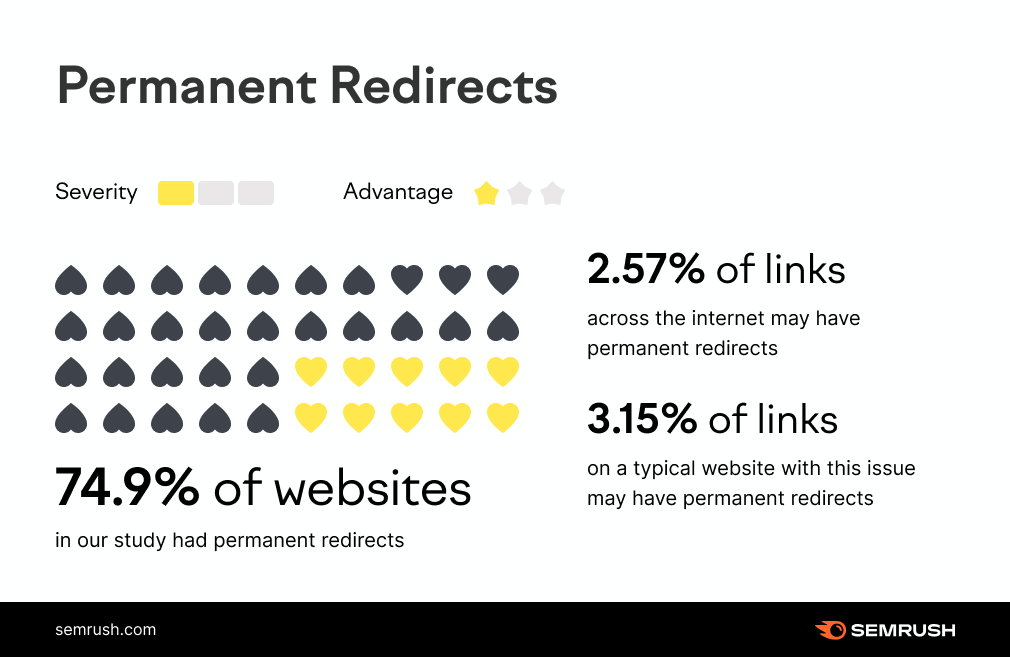
In the beginning, I mentioned how website redesign SEO processes aren’t without risk. The greatest of those risks is the potential of losing a lot of the hard work you put into building your organic profile.
A website redesign is going to change the structure of your entire site. Some pages will get moved, some will even get deleted.
The thing is, small changes can make a big difference in SEO land. As much as 60 percent of marketers say SEO and content marketing is their biggest source of leads.
Let’s go back to our amazing article on “How to Scale Mount Everest” that’s bringing in lots of organic traffic.
The problem is you posted it in a category that’s not very accurate, and you gave it a messy URL structure. Naturally, you want to fix this, so you change the category and URL.
You haven’t even touched the content, but this change can have huge consequences. This is because there are links out there already pointing back to the old URL, so when people (and bots) follow them, they end up at a blank page.
Unless you use URL redirects, you’re not only losing your referral traffic, but you also lose the page and domain authority those backlinks have already built up.
Essentially, your well-established and successful article has to start from scratch all over again.
Redirects can get very messy with a large website, so it’s important to carefully map them.
How to map URL redirects:
- Create a list of all URLs you are keeping as well as those you will no longer be using.
- Create another list of content you plan to keep that will be under a new URL.
- Match each old URL with its new URL. For the URLs you are getting rid of, match each to new content that covers a similar topic. Give the list of new content mapping scenarios to developers to implement the redirects.
4. Optimize Content You’re Keeping
After doing your content audit, you should have a good idea of what content you plan to keep. If you’ve put the time and effort into your audit, you will likely have flagged some areas of improvement for some of your best pages.
A website redesign is a perfect opportunity to refresh old content and give it a new lease of life. This process alone can increase organic traffic by as much as 106 percent.
Content decay is real. New information comes to light, competitors invest in their content, and suddenly your best pages have been pushed down the rankings.
Click through rates for the top organic rankings drop off extremely quickly:
- 1st result: 34.2 percent
- 2nd result: 17.1 percent
- 3rd result: 11.4 percent
- 4th result: 8.1 percent
- 5th result: 7.4 percent
Dropping from the top rank can immediately cut your organic traffic in half, so it’s important to optimize your existing pages.
Your website redesign SEO should help with the UX side of things, but what else can you do to improve content rankings again?
- Use Google Search Console or an SEO tool like Ubersuggest to see how your content is performing.
- See what keywords your top-performing content pieces are ranking for. To improve those rankings, even more, add target keywords to headers, increase keyword density (without stuffing) throughout the post, and use keywords in image alt text and file names.
- Dig into content that isn’t performing well. Make improvements by rewriting it or updating it with recent links and studies as well as data points, expert interviews, and visuals or videos.
5. Optimize Page Speed
You can’t underestimate the importance of page speed. Everyone knows the feeling of waiting forever for a page to load, and you know what users do when that happens; they leave and look for information elsewhere.
Technology has made people expect things much faster these days, and interacting with a website is no different. 25 percent of people leave a website if the page takes more than four seconds to load, and a one-second delay results in a 16 percent drop in customer satisfaction.
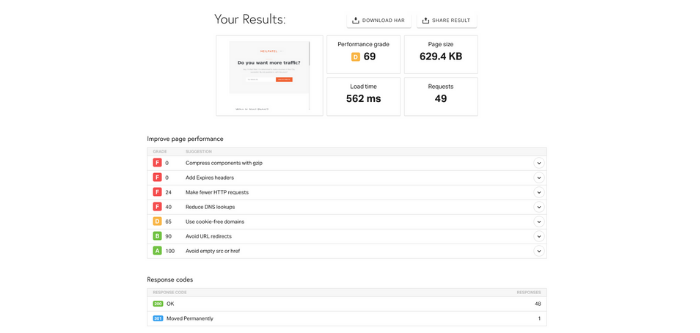
Websites tend to become bloated over time. A website redesign SEO process lets you take the opportunity to optimize page speed by addressing the bloat.
First, you want to make sure images are optimized to the correct size and format. Make embedded videos load properly and, if they don’t, use tools to decrease the file size or shorten the videos.
Next, reduce the number of HTTP requests. You should also minify your CSS and JavaScript, and clean up your HTML.
This should be something you consider from the very start of your redesign, and you need to stress it as a priority for your developer.
6. Update Your XML Sitemap
Your XML sitemap is like your website blueprint. Google and other search engines use it to understand the purpose of your content and it’s crucial for good website redesign SEO.
You can either do this manually by adding every URL in your updated site to the map or use an SEO plugin like Yoast or AIOSEO to generate one automatically.
This is a simple but important step. If Google is looking at an incorrect XML sitemap, their crawlers may ignore your site entirely (as confirmed by Google’s John Mueller).
7. Test Your Site After Redesign Is Complete
Across the internet, 0.27 percent of internal links are broken and 1.37 percent of external links are broken. Broken links are just one of the many issues you need to consider when testing your website after a redesign.
Redesigning an entire website is a huge undertaking so every detail isn’t going to come out perfect straight away.
If you launch your new site immediately without testing it first, these imperfections can have big consequences.
It’s tempting to get the ball rolling and start with your new website as quickly as possible, but you’ve got to put time into testing. Review all of the changes on your test site (get your friends and family on board as well) and go through the website with a fine-tooth comb.
You can create specific tasks for everyone involved in user testing your site.
- test CTAstest site navigation (it should make sense and all tabs/navigation links should be clickable)look at side navigation links
- Review forms, pop-ups, and exit overlays if you use them
- audit internal and external links
- pay close attention to interactive content and purchasing pages
- have people text on desktop, tablets, and mobile devices (Android and iOS)
Add any errors you find to a spreadsheet and go through them with your developer.
Again, it’s about exploring your website through the eyes of your target audience. If you do this well, then you’ll fix a lot of errors before they reach the end-user.
Website Redesign SEO Frequently Asked Questions
How much do website redesigns affect SEO?
Website redesigns can have a big impact on SEO. When done well, the improved UX can boost rankings, but if the redirects aren’t carefully mapped, it can lower your authority and result in your website losing a lot of organic traffic.
How much do website redesigns for SEO cost?
The cost of a website redesign will depend on the complexity of your website. Basic redesigns can start at around $15,000 but more complicated ones can cost upwards of $75,000.
What are the most common SEO errors in website redesigns?
Some of the most common SEO errors with website redesigns are forgetting to redirect URLs and not keeping your most successful content.
What SEO tools do I need for website redesigns?
SEO tools are useful for website redesigns because they allow you to evaluate your performance. Your Google Analytics is essential, but ranking checkers like Ubersuggest can also be very useful.
Conclusion: Website Redesign SEO
There comes a time when you need to think about website redesign SEO. This is an important moment for your business, and it needs to be handled with care.
A website redesign carries lots of risks when it comes to SEO, but at the same time, it can offer lots of rewards. To maximize those rewards and minimize the risks you need a clearly defined strategy and that is where this website redesign SEO checklist can help.
That covers the SEO side, but I’ve also got some more tips on how to safely carry out a website redesign, so check them out.
Are you planning a website redesign? Let me know in the comments below!
Source: neilpatel.com

What No One Talks About When it Comes to Successful B2B Influencer Marketing
Whether you’re just starting to explore B2B influencer marketing efforts or you’re well on your way to putting influencer content in place, there are myriad articles that can help you plot out the major steps to success.
However, many of those articles don’t quite dive deep enough into some of the often overlooked yet oh-so-critical details that happen in between those big steps.
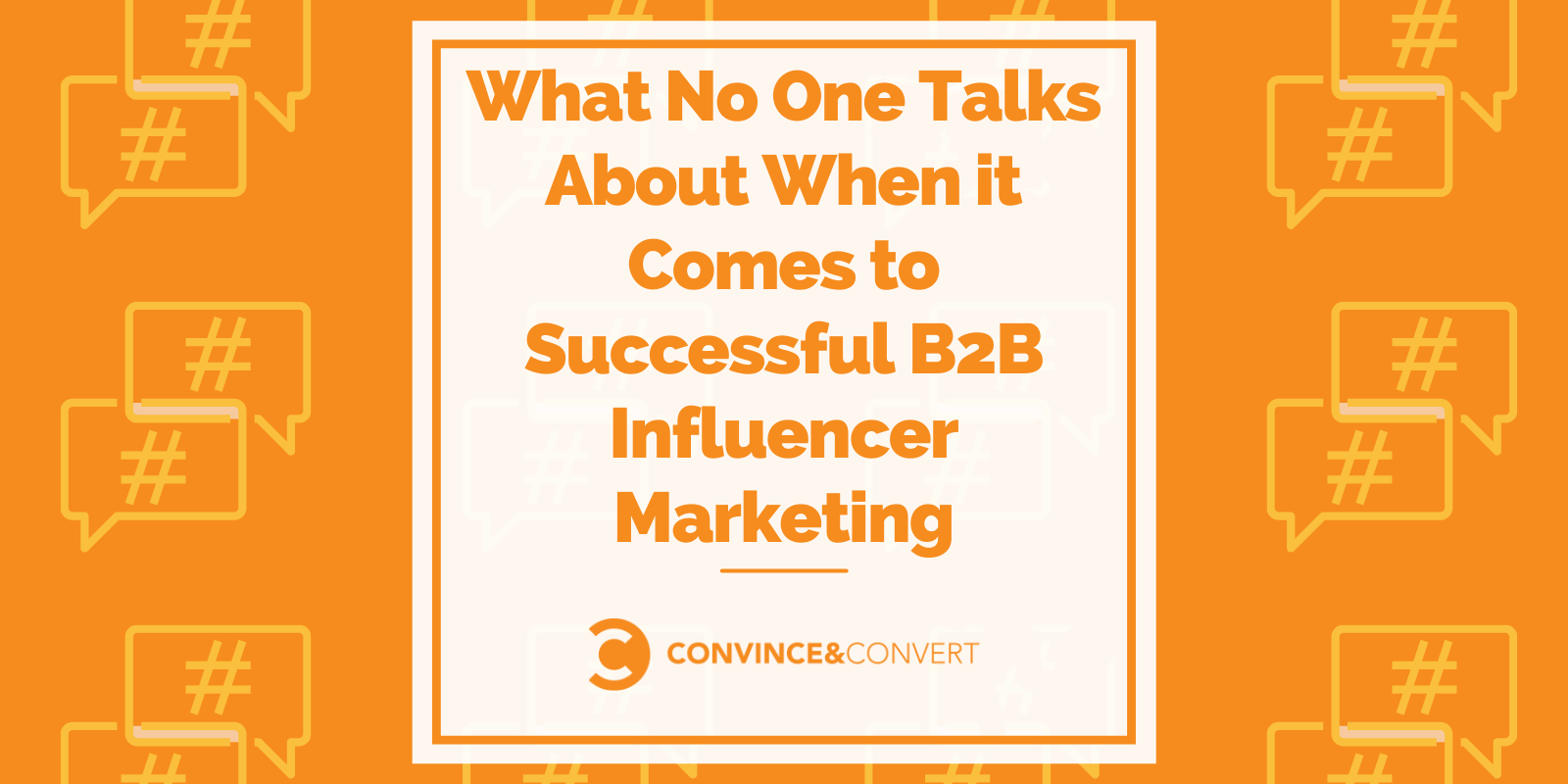
Sometimes, that understanding comes from experience. In this case, it comes from our experience, and we’re happy to share it so you can avoid common mistakes and missteps along your B2B influencer path to success.
You Need More B2B Influencer Meetings Than You Are Thinking
Whenever anyone talks about the process of getting B2B influencer marketing efforts off the ground, they make it sound like all you need is to identify influencers, reach out, agree on the scope and then content magically appears.
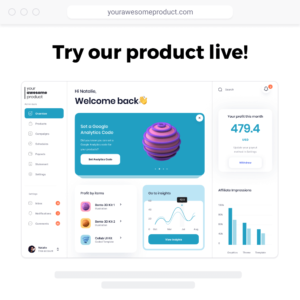
While that process is kind of true, it’s also not the whole picture either. It actually leaves out a plethora of meetings.
No one wants another meeting on their calendars, but conducting a lot of the right meetings is essential for B2B influencer marketing success.

Instead of one big meet-and-greet-scoping-contracting-kickoff meeting, schedule smaller, more intentional meetings:
- Initial meet-and-greet: You’re forming a new business relationship, so use this time to get to know the influencer on a personal and professional level. Talk about what they like to create, what they don’t like to create, the topics they usually cover, their upcoming availability, and overall bandwidth. Also, let them get to know you and/or your team, too.
- Vision/goal setting meeting: After the meet-and-greet call, come back to the table with some initial ideas and options for how you and the influencer can work together, but make sure there’s room for the influencer to ideate and brainstorm, too. This should be the time you both talk about goals for working together.
- Formal scoping call: Once you and the B2B influencer are on the same page for the vision and goals, put together a formal scope of work based on your conversation. Be sure to include essential information, like what exactly is being created, when and for how much. Then, go through all of it, together. Make sure any gray area is cleared up and all questions are answered.
- Official project kickoff: Formally kickoff the project(s) to signify the official start of the scope. Get on the same page about deadlines, assign the main point of contact for the influencer, and set creation expectations. While this seems like it might be over-the-top, it’s also creating a fresh start and giving everyone clear direction on how and when to move forward.
Regular check-in meetings (as needed): Depending on the final B2B influencer scope, you may want to have weekly, biweekly or monthly check-ins, just to make sure you’re on the same page and give yourselves the opportunity to talk through any details or issues that may come up along the way.
Of course, your meeting cadence and schedule will be completely dependent on what you’re using B2B influencer marketing for and what the scope of engagement looks like. Just be prepared to have a lot more meetings than you might think are necessary.
Also, remember to keep every meeting focused on accomplishing the next steps or a specific set of goals. That way, meetings will never feel excessive and they’ll be more like working sessions instead.
Tailor Your B2B Influencer Marketing Ask to the Influencer’s Talents
Not all influencers are writers. Not all influencers are speakers. Not all influencers are social media and content marketing strategists. It’s actually incredibly rare to find a B2B influencer who can do it all, so don’t jump into B2B influencer conversations with the expectation that they can. Instead, tailor your content to their talents.

While this may seem obvious, it can be hard to remember when you have a big vision and finally find a B2B influencer who is a great match for your goals and organization or get wrapped up in brainstorming.
Of course, you’re going to want them to create all the amazing things and be part of exciting co-creation efforts! They also might feel pressured to live up to those expectations or feel like it’s a deal-breaker if they can’t, so don’t put them out there, to begin with.
Just keep in mind that you likely aren’t the world’s best writer, editor, videographer, speaker, social strategist, and content marketing specialist all rolled into one, so don’t expect your B2B influencers to be the same either.
Be Prepared to Get B2B Influencer Content in Other Ways
Let’s say you have tailored the influencer marketing ask to the influencer’s talents, but they don’t have the bandwidth to take on a huge ebook project, or the availability to put together a full webinar, or even the time to put together a blog series. That’s ok because you can get creative with how B2B influencers can create and contribute:
- Interview B2B influencers: Have them get camera-ready and sit down for an old-fashioned interview. Give them questions that can help you get the content you need to piece together an ebook, a social series, blogs, and more.
- As a bonus: because they’re camera-ready, you can slice up and reuse the recordings of that interview, with influencer permission, of course.
- Have them record short-form videos: B2B influencer contributions don’t have to be massive all the time. Simply having a great idea + short-form video can be really powerful. This is exactly what Oracle Marketing Clouds did for their On the Fly series, where B2B influencers recorded short pieces of marketing advice while on the go in airports, train stations, and more.
Use a staff writer to work with the influencer: Sometimes you might just have to help the B2B influencer get their thoughts out of their head and onto paper, which may take a staff writer working directly with them. In this scenario, have the writer set up multiple working sessions with the B2B influencer. Then, the staff writer can bring the influencer’s own words to life.

Yes, it might be ideal to have B2B influencers create and deliver their own content from start to finish, but that just might not be possible all the time. Thankfully, there are plenty of backup options to still get that great B2B influencer-originated content.
Treat B2B Influencers Like a Contractor and a Client
While you may technically be “hiring” a B2B influencer, they don’t work for you. They’re working with you. Instead of viewing the relationship as you hiring someone to create content, look at your B2B influencers more like contractors or clients.
It’s a mutual working relationship that takes a lot of work, and they have other clients and a whole other business of their own to run, too.
Also, B2B influencers are very, very connected to a much larger network, and they know through the grapevine who is great to work with and who they wouldn’t work with again.

Need Help with Making Your B2B Influencer Marketing Successful?
Our team of strategists is here to help you. Contact us today.
The post What No One Talks About When it Comes to Successful B2B Influencer Marketing appeared first on Content Marketing Consulting and Social Media Strategy.
Source: convinceandconvert.com

15 Conversion Rate Optimization Tips to Boost Your Rankings
Conversion rate optimization, or CRO, is the process of optimizing your website to increase the completion of a specific action. In most cases, the desired action is an actual sale, but not always.
Desired actions could include demo sign-ups, downloading an asset from your website, trying out a new tool, or signing up for your newsletter. If it helps you grow your business, it’s a conversion—and it can be optimized.
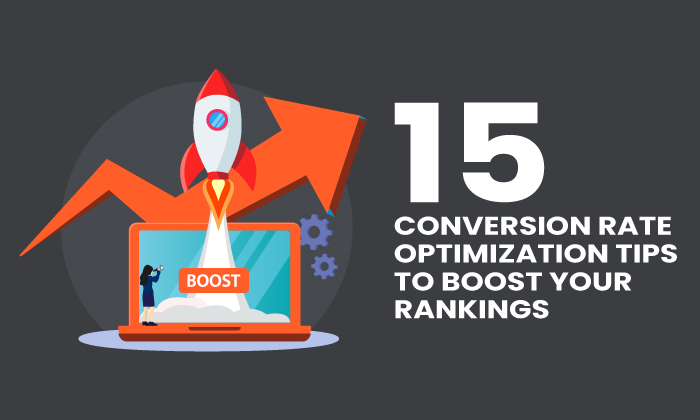
The beauty of these conversion rate optimization tips is they work regardless of your intended conversion method.
CRO Tip 1: Add Site Search to Your Website
Up to 30 percent of visitors will use a search box if it’s offered. Unfortunately, nearly 84 percent of companies don’t optimize their on-site search to meet user expectations.
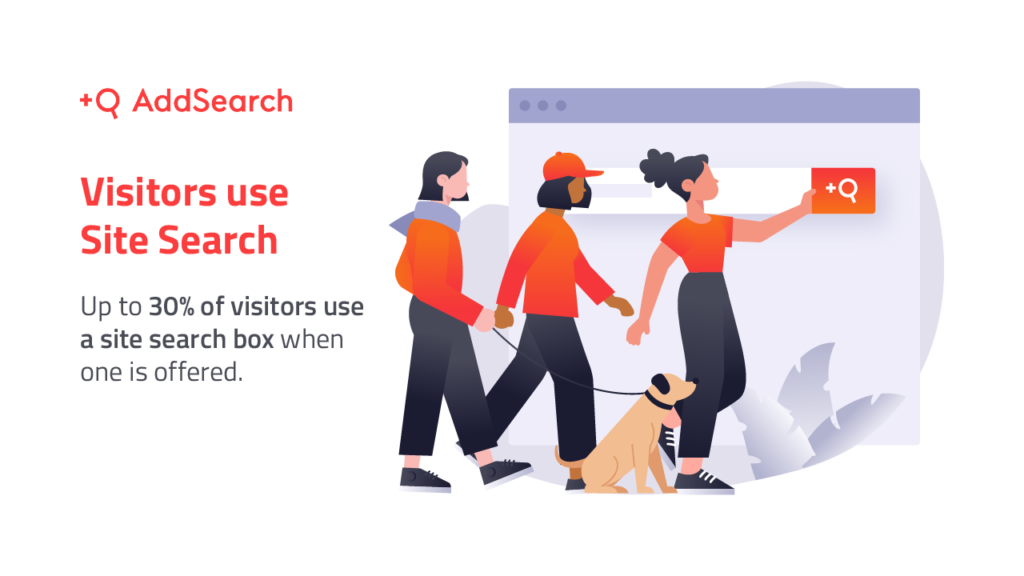
This means if your website doesn’t already include a site search, it’s time to consider adding it.
The main benefit of site search is user experience. However, data from search results can provide valuable insights into user behavior by showing you exactly what they’re searching for.
This information can help you tailor content to meet those needs or add new pages to your site to fill any gaps.
You may even be able to identify users in different parts of the funnel based on the search terms they use. This information can help you to narrow your customer’s most common questions and pain points, helping you tailor the website experience to their needs.
If you use WordPress, you can add a site search using a widget. If you use Webflow, they’ll actually let you customize it. Wix and Squarespace make it easy to add site search as well.
CRO Tip 2: Ensure Forms Are Easy to Fill Out
The average form abandonment rate is 68 percent—which means most people won’t finish filling out your form.
Website forms serve many purposes, including newsletter signup, lead magnet acquisition, and product/service inquiry.
Keep in mind: the easier a form is to fill out, the higher your expected conversion rates.
According to Hubspot research, a typical form has about 5 fields on average—and forms that are A/B tested get about 10 percent higher conversion rates.
In my experience, simple is better.
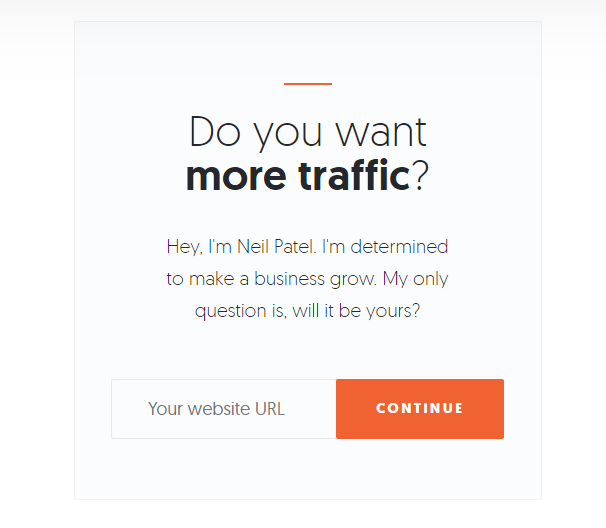
This is an example of a simple form I use on my blog. All the user needs to do is enter their website’s URL and the action is complete. It doesn’t get much simpler than that.
A few ways to ensure your forms are easy to fill out:
- make form names clear use proper HTML formatting
- use relevant sample placeholder text (I used “Your website URL” in the example above)
- have a distinct and easy-to-local submission button
CRO Tip 3: Improve your CTAs
If you want to improve conversions, CTAs are low-hanging fruit. The average CTA click-through rate is just 4.23 percent, but many factors can impact what helps your CTA convert.
For example, if you include more personalization in your CTAs, conversion rates can improve more than three times as much.

That’s why you should continually test CTAs to see what works and what needs improvement. You’d be surprised at how quickly user preference can change!
Start by testing these CTA elements:
- copy
- colors placement
- button shape
- button size page placement
Consider testing different types of CTAs as well. Here’s how CTA types convert, according to a study by Vye Agency:
- button CTAs have an average CTR of 5.31 percent
- text CTAs have an average CTR of 2.06 percent
- designed CTAs have an average CTR of 3.53 percent
When it comes to branding, consistency is key. However, using colors outside of your branding palette for CTAs is worth trying. Colors within your palette might blend in too well with the rest of your site, making them easy for website visitors to overlook.
CRO Tip 4: Run User Testing
Poor usability can kill your business. 70 percent of online businesses fail because of poor usability.
If you’re in e-commerce, your conversion rates could increase by 35 percent by just improving the design and flow of the user checkout process.
User testing is the way to get valuable data that can help you get more conversions across your website. So it’s important to get this process started as quickly as possible.
One of the most common ways to run UX testing is with heat maps, which show how users navigate your site and what interactive elements they’re clicking on.
You’ll see if they’re looking at your links, navigation bar tabs, CTAs, and so on. Some heat maps even incorporate eye-tracking software to show where your users look first.
There are several heat mapping tools on the market, but my favorites are Crazy Egg and Hotjar. If you decide to use Hotjar, the process for setting them up is very simple and straightforward.
CRO Tip 5: Add More (Better) Social Proof
More consumers than ever read social proof. In fact, 77 percent of users say they always or regularly read online reviews before buying.
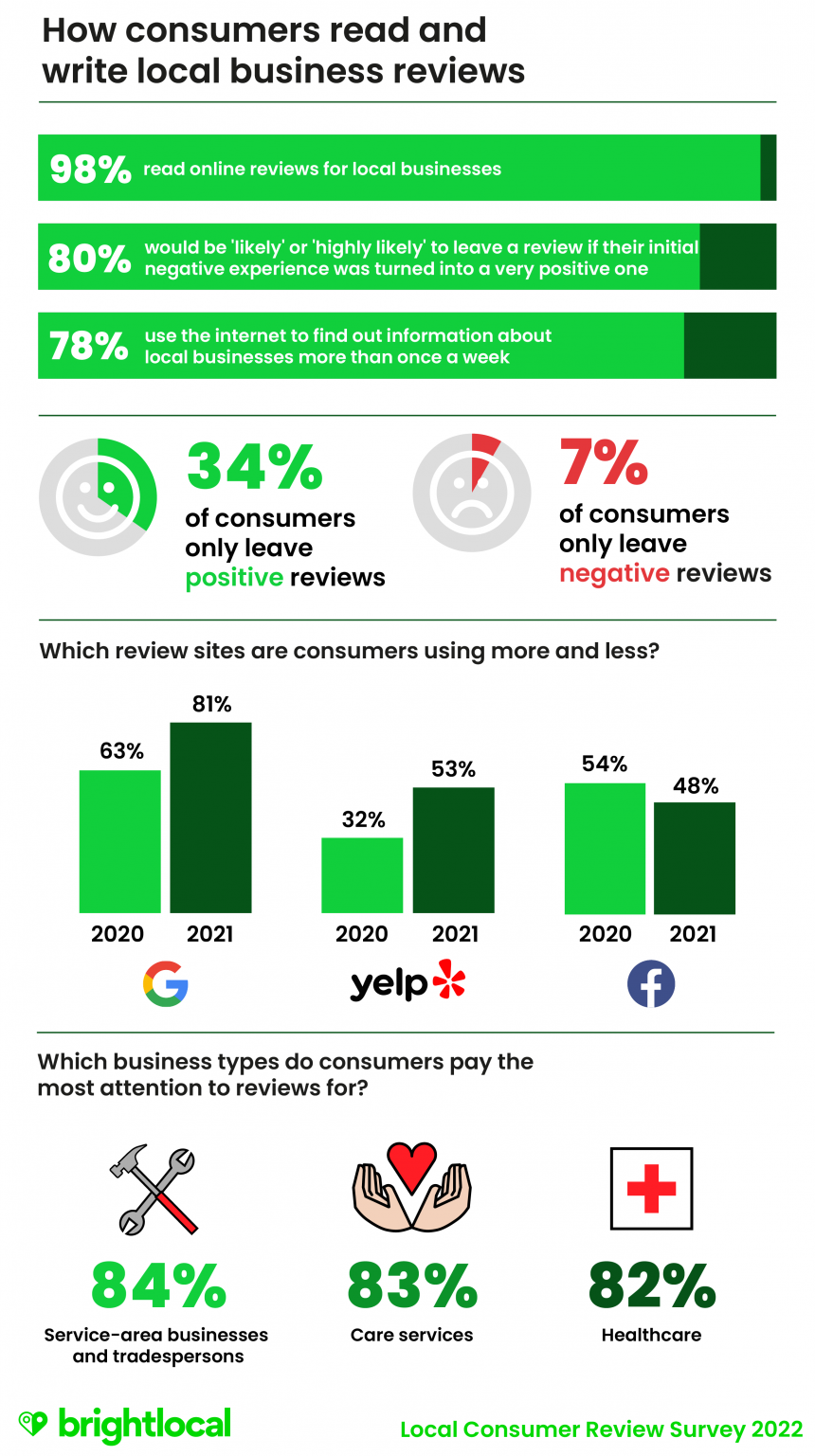
You want to leverage customer loyalty as often as you can. Why? It’s free marketing and brand exposure. Even better, reviews can drive revenue.
According to Womply, businesses with more than average reviews across earn 54 percent more in annual revenue
It is also easy to create.
Social proof is a simple and great way to leverage user-generated content for your brand. This can include positive reviews and ratings, creative social media posts about your brand shared by customers and influencers, user-submitted content like photography, and more.
The benefit of adding more social proof to your website is it shows other users that other people trust you. Trust and credibility play a big factor in getting more conversions.
To add more social proof, try:
- Send a follow-up email asking for reviews.
- Host a contest with a branded hashtag on social media.
- Include a card with a branded hashtag when shipping physical products.
If you want to do it on a larger scale, consider automated tools like HotFomo and OptinMonster.
CRO Tip 6: Add Chatbots or Live Chat
If you have a question, wouldn’t you rather get the answer fast? That’s the idea behind chatbots. No matter how great your customer service is, sometimes call queues to get long.
The good news? Users like chatbots. The average satisfaction rate of chatbots is 87.58 percent. They can also reduce customer service costs. One study predicts chatbots will save businesses $8 billion in customer service costs by 2022.
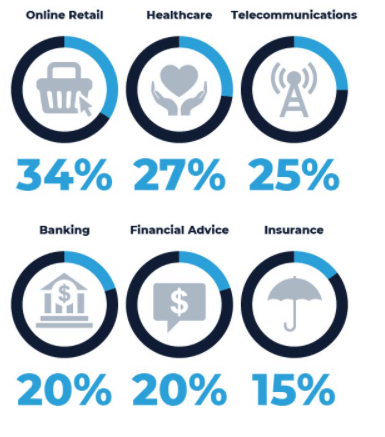
These tools help your brand build an instant connection with customers, making them more likely to purchase your product or service. Here are a few ways to leverage chatbots;
- answer FAQ
- qualify leads
- suggest related products
- troubleshoot common issues
- Share information about new products
- increase your email list
With so many chatbot options available, it can be challenging to find the right one. I recommend focusing on native channel integrations to narrow your search.
If you want an app with widespread integration options, consider Landbot, which offers chat features through the web, WhatsApp, Facebook Messenger, and API.
Perhaps you just need to integrate with Facebook Messenger? In that case, Chatfuel is an affordable solution.
Make sure that whatever chatbot you choose aligns with your business goals.
CRO Tip 7: Review Customer Persona and Adjust Your Messaging
A customer persona is a fictional snapshot of your ideal customer. Personas are commonly used by marketing agencies and businesses to give their target audience a human face. They can help drive leads, increase conversions, and shorten the sales cycle.
According to MarTech, creating a persona can increase email CTR by 14 percent—and conversion rates by 10 percent.

The gap between who you think your ideal customer is and your actual customers may be more significant than you think.
For example, if your personas are businesswomen in their early 30s but your customer base is primarily homemakers in their 50s, there’s going to be a massive disconnect in how you approach your target audience.
Here are six steps you can take to make sure you are targeting the right customer personas:
- Make a list of your highest value customers.
- Use a customer persona template to create a new persona.
- Start adding details from your highest value customers.
- Start with demographics like location, age, budget, education, etc.
- What channels do your highest value customers use to find you?
- Add that to your persona as “methods of communication.” Look at the content they consume—what does that tell you about their motivations?
- Add those to your template.
- Repeat the process for every product or service you offer.
It’s important to realign your customer personas with your messaging, sometimes as frequently as every two or three months. In some cases, this could mean tailoring your brand approach altogether to connect with the new target audiences working.
CRO Tip 8: Use Targeted Lead Magnets
Lead magnets are a free resource (like an ebook or guide) given away in exchange for user data. The most common lead magnets are PDFs or videos, but there are plenty of media types to use.
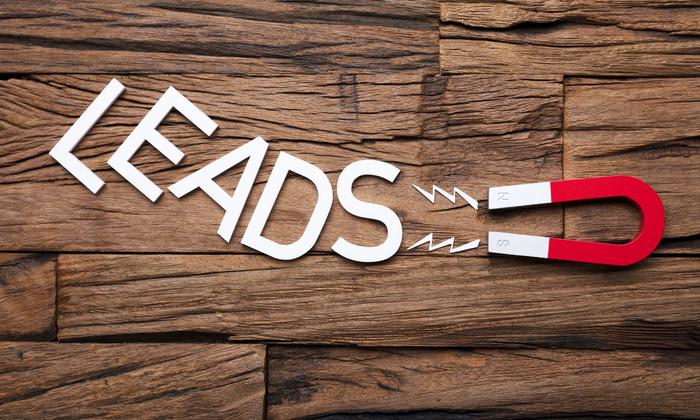
The best part? They work.
Fifty percent of marketers say lead magnets increase their conversion rates.
The more targeted your lead magnets, the more effective they are likely to be. The key is to get creative with your targeting.
You could even consider creating some more interactive lead magnets like quizzes or online calculators. According to LeadQuizzes, the average quiz has a lead capture rate of 31.6 percent.
The way you target your magnet will depend on your product or service. For example, if you serve a geographical area, it may make sense to target leads based on location. Other websites might target leads based on industry or how they got to the site.
Here are a few other targeting options:
- time on page
- type of content
- whether they’ve purchased before
- industry
- customer persona
- location
- time period (for example, a pop-up for an upcoming event)
Not sure how to add targeting to your lead magnet strategy? These lead magnet tools can help.
Whatever type of lead magnet you decide to create, be sure it aligns closely with your intended customer. Since the goal of lead magnets is to collect user data, you want to make sure the offer is valuable to your intended audience as well as your business.
CRO Tip 9: Use Pop-Ups Carefully
Pop-ups have an average conversion rate of 3.09 percent, which makes them ripe for CRO.
I have a love/hate relationship with pop-ups because they walk such a fine line between being beneficial (for you and your customer) and incredibly annoying. However, when done right, pop-ups can be an invaluable conversion tool.
In fact, Marketing 112 increased its conversion rates by 62 percent by adding a pop-up to its website.
First and foremost, your pop-ups should respect universal UX rules. These include fast load times, visible exit options (like the example from Wishpond below), and platform-appropriate size.
There should also be limits as to how often users see the pop-up. For example, a user who bypasses the pop-up once shouldn’t be bombarded with it on each page of your site they navigate.
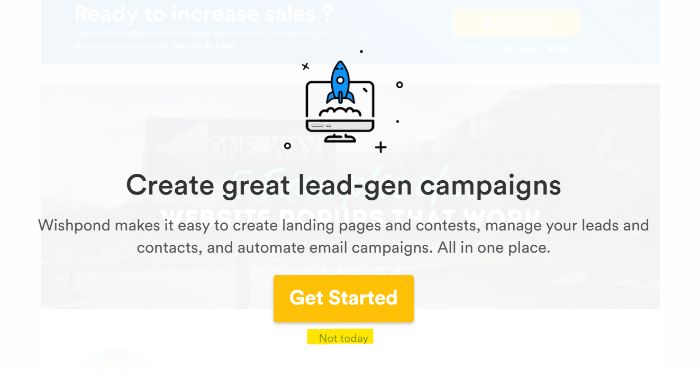
When it comes to conversions, keep the messaging short with minimal effort to take the desired action.
You can also implement A/B testing to see how users interact with different versions of the pop-up. This is important for optimizing conversion rates across the board.
CRO Tip 10: Check Your Site Speed
If your site loads slowly, all of the conversion rate optimization tips in the world won’t make a difference. In fact, website conversion rates drop by 4.2 percent for each additional second your site takes to load.
Even more surprising? More than 80 percent of sites don’t meet acceptable speeds.
Fortunately, there are plenty of free sites and tools that let you test your site speed and troubleshoot common issues.
PageSpeed Insights and Pingdom are two of the industry leaders in this domain. These tools have been around for years and offer the most in-depth testing and troubleshooting. They first look at contentful paint, time to interact, and total blocking time to calculate your overall score.
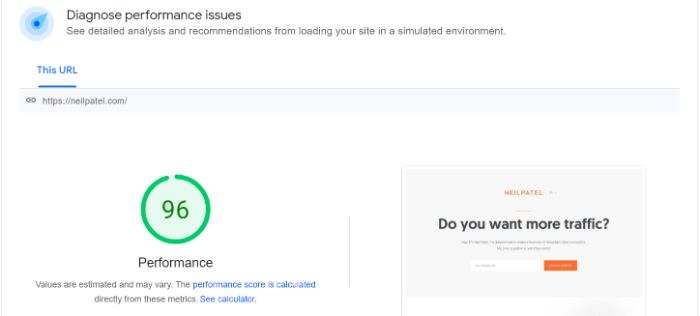
What are some of the most common issues that slow down site speed?
- render-blocking JavaScript
- poorly optimized CSS
- large media files
- bulky code
While some of these may require a database engineer or developer to resolve, you can usually start to tackle some issues (like large media files) on your own.
CRO Tip 11: Recover Lost Sales by Following up on Abandoned Carts
According to the Baymard Institute, the average cart abandonment rate is 69.82 percent. That rate is even higher on mobile where the average shopping cart abandonment rate is 85.65%.

Recovering just a fraction of those missed sales could do wonders for your conversion rate.
If the main benefit of CRO is converting users already on your site, then abandoned cart users are the cream of the crop. They actively started the transaction but didn’t complete the purchase.
There may be some obvious reasons for this, such as a discount code no longer being valid or high shipping rates. Whatever the reason, you should always aim to recover the lost sales using (almost) any means necessary.
In fact, if e-commerce sites just fixed checkout usability issues in their process, they could increase conversion rates by 35.26 percent. This translates into more than $200 billion in recovered sales from the e-commerce industry alone.
Here are some other ways you can recover abandoned carts:
- automated email flow
- son-site push notifications
- retargeting ads
- personal outreach
- automated social outreach
You don’t want to harass potential customers who have abandoned carts, but you do want them to feel wanted. Sending just one email could help you recover up to 29.9 percent of these sales.
You may want to play with your outreach timelines to find the right approach for your customer base.
CRO Tip 12: Make Sure Landing Pages Match Your Messaging
The average landing page converts just 2.35 percent of the time across all industries. If you want to be a top performer in your sector, you should be aiming for conversion rates above 10 percent.
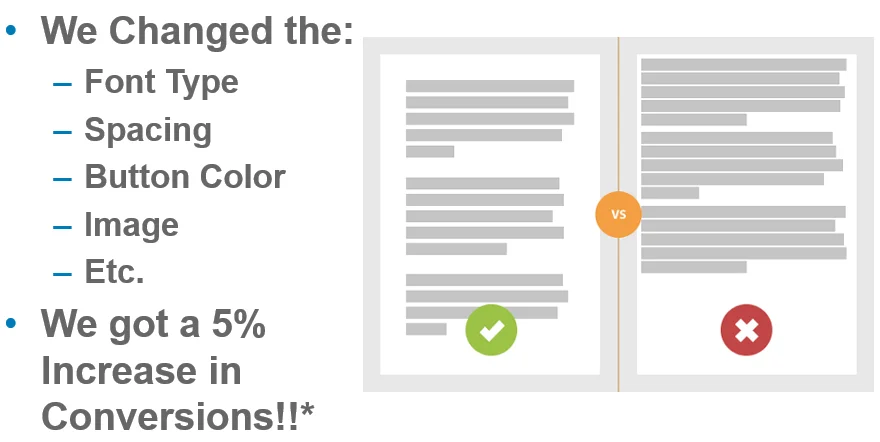
So, how do you increase your landing page conversion rate?
One way is to ensure the messaging on your landing page matches the ad or copy that brought them there in the first place. This creates a more cohesive experience, showing users that your page is the right fit for what they want. It will also help improve your PPC quality score.
Here’s how to match your messaging:
- use similar language in your landing page and ad (especially the main keywords)
- keep branding consistent (include your logo and use brand colors)
- use a clear CTA on both your ad and landing page
Just imagine how off-putting two distinct messaging styles can be to the user. Imagine if you agreed to a job interview for a tech company and found out it was a restaurant when you arrived. It would feel like a bait and switch, right?
While a difference in messaging between an ad and landing page isn’t quite as off-putting, it’s close. The differences can be jarring and steer users away.
When creating your landing pages and ad copy, make sure you have a clear focus in mind. This would start with your keyword research when you select the target phrase for the page. You can include some secondary keywords on the landing page as well if you plan to use them in your ad copy.
CRO Tip 13: Target High Intent Users
High intent users are very close to making a buying decision. According to a report by the CMO Council, 87 percent of B2B buyers say that online content has a major or moderate impact on the vendor they choose.
That means there’s an extremely high opportunity to improve your content to convert these users.
How can you target high-intent users?
As previously mentioned, looking at the internal search terms users interact with on your site is one way to get an idea of content that works. Someone at the bottom of the funnel might be trying to distinguish between different options, so they’ll be looking more closely at shipping timeframes and return policies.
Here are a few other strategies:

- Add high-intent keywords to your ads and landing pages.
- Use the information from your internal search to gauge what keywords are and how your customer base interacts with them.
- Build content that targets customer pain points.
- You can often identify these pain points with SERP analysis of high-intent keywords.
- Pay attention to intent data.
- Contact users who visit your pricing page, return to your site several times, or book a demo but don’t follow up.
High intent users are ready to convert, so don’t leave them hanging.
CRO Tip 14: Optimize Your Content
If your content isn’t performing well, it’s time to re-evaluate and optimize it. The first thing to check is title tags.
According to Backlinko’s research of more than 11 million Google search results, sites that include the main keyword in their title tag are far more likely to rank higher.
Content optimization looks at a number of factors including:
- Make sure the keyword is used several times content length variance (add or remove content)
- check image optimization, such as size and alt tags
- add stats and new research check meta and SEO titles
- add keywords to more headings
- add a frequently asked questions section
- make sure you aren’t cannibalizing traffic from other content on your site
For time and efficiency, you don’t have to do all of the above. Instead, research the top 10 results on Google for your target keyword and see how they are structuring their content.
Their approach is clearly having an impact on their ranking and can provide a path for you to improve your search engine rankings.
CRO Tip 15: Before You Make Changes, See What Works Now
It’s easy to see all of the things that need to be improved, but what about the things that are working?
There are likely some areas of your website that are already working. For those, look for patterns in what the data is telling you, determine what the essential parts that led to the results might be, and come up with an approach to replicate this across your site.
If you aren’t sure how to approach this yourself, you can hire a professional to audit conversions across your website and highlight what is working well. This process alone could uncover a lot of great things you’ve been doing but probably don’t realize.
The last thing you want to do is a major content overhaul that loses conversions from pages or strategies that are already working.
Frequently Asked Questions About Conversion Rate Optimization Tips
What is conversion rate optimization?
Conversion rate optimization (CRO) is the process of increasing the conversion percentage for a website or mobile application. The aim is to increase the number of people taking the desired action in relation to the number of visits by improving customer experience and testing interactive elements.
What is the most effective CRO strategy?
There’s no one way to approach conversion rate optimization. However, a good CRO strategy will focus on user experience optimization, customer journey analysis, and website performance.
Is CRO different for ecommerce?
The benefits of CRO are the same whether they’re being implemented for an ecommerce site or not. However, the processes may differ slightly. When it comes to ecommerce, the conversion funnel has a larger part to play than it might on a non-ecommerce site.
How can conversion optimization affect your return on investment?
In simplest terms, CRO aims to make the most of the site traffic you already have. By increasing the conversion of your existing traffic, you have the potential to lower your customer acquisition costs.
Conclusion: Conversion Rate Optimization Tips
When you consider the fact that customer acquisition is more than half of the battle, it makes sense to focus heavily on conversion rate optimization.
After all, converting more of your existing website traffic could drastically reduce customer acquisition costs.
You’ll notice most CRO tips focus on improving the user experience and enhancing the customer journey. That’s because they tend to have the most significant impact. However, you don’t have to implement all of these CRO strategies immediately. Think about which will have the most significant impact and test those first.
Which of the CRO tips above do you think will have the most impact on your conversion rate?
Source: neilpatel.com

Google Ads for eCommerce: How to Make Your Website Conversion-Ready
So, you’re eager to run Google Ads for your eCommerce business.
You took all the critical first steps to ensure your business is set up for Google Ads success—your brand identity is rock solid, your budget and time expectations are reasonable, your selling proposition is one-of-a-kind.
The next step? Make sure your website is ready to convert.

After all, those precious ad clicks will lead customers to your virtual front door. And we need to make sure that the door is open wide to welcome each visitor before we spend time and money on Google Ads campaigns.
Here’s how we’ll make that happen:
- Website CRO Best Practices
- Product Preparation
- Media (Images and Video)
- Lifestyle Images
- Robust Titles and Descriptions
- Live Chat
First Up: Website CRO (Conversion Rate Optimization) Best Practices

Building an eCommerce store isn’t that hard.
Building an eCommerce store that converts? Whew! That is a different story entirely.
Here are some CRO best practices to ensure your site is ready to make sales:
The Big Three:
1. Website Issues and Errors
You can’t drive traffic to a broken website. So, it’s crucial to ensure you catch any website issues or errors:
- Frequently (at least once a month) check your site and make sure everything is working properly and there are no high-risk issues and errors.
- Schedule a website audit at least once a month.
2. Website Speed
Website speed has a massive impact on your quality score; in fact, it is considered slightly more important than content(!) according to Google. A few things to consider:
- Mobile users are going to be less tolerant of slower websites due to the smaller size of the device and often slower connection.
- The biggest contributing factor for slow sites is large image sizes.
3. Mobile Engagement
- 60-65% of website visits are done on mobile devices. So ensure your site is mobile-friendly!
- Look at your conversion path: although many purchases happen on desktop computers, research is often done on mobile devices. In other words, consider each step of your buyer’s journey so you can make it as effortless as possible.
Conversion Rate Optimization Checklist

Now let’s put those best practices into action. First up, run through this CRO checklist to make sure visitors have a smooth journey to purchase from your site:
- Everything works properly
- Website is fast (under 2-3 seconds load time)
- (use PageSpeed Insights to measure this)
- Your email/phone number is in the header or footer
- Customers need to know they can trust you (i.e. get in touch with you)
- Website design is appealing to your audience
- Make sure the design is centered around your product and isn’t a distraction
- The website has high-quality images
- Products are described clearly with all features displayed
- CTAs are in a contrast color (bold!) and easy to find
- Check out BOOM by Cindy Joseph for inspiration
- There are reviews on product pages
- Verification badges (secure payment, BBB, SSL, guarantees, free returns, etc.)
- This helps improve the trustworthiness of your site and brand
- Turn anything you offer into a badge (free shipping? Make it a badge! Free returns? Badge! Much more exciting than text)
Website Speed Optimization Checklist
- Choose a “light” theme
- A good developer can improve your site speed a lot—but make sure you don’t rely too heavily on customization
- Scale your images properly
- Try PicResize
- Decrease the weight of your images without losing quality
- Try TinyPNG
- Limit the number of plugins/apps
- Limit the number of displayed products on category pages
- Check-in on your page speed
- Try PageSpeed Insights
- Don’t aim for a 100/100 score—just aim for a good user experience
Quality Assurance (QA) Checklist:

Include quality assurance checkups in your monthly standard operating procedures to make sure your site is in tip-top shape. You can do this through internal QA and external QA:
Internal QA: Pretend to be your own customer
- Try to break the site
- Navigate through your site the way a customer would
- Gauge how easy it is for a distracted customer to use your site.
- Ask yourself, “If I weren’t paying full attention, could I still do this?”
- Make an actual purchase
*You can hire someone to go through your site on Fiverr.
External QA: Have someone else pretend to be a customer
- Just tell them where you want them to go—but not how to get there
Analyze Top Competitors:
- What is different between their website and yours?
Pro-Tip! Diagnosing Issues: Screen Recording Software
You can install screen recording software on your site that tracks users’ navigation via heat mapping (note: it will likely slow the speed of your site). This works on desktop and mobile—so for eCommerce sites that aren’t converting, you can use this software to figure out what’s going wrong along the way.
Here are a few notable options:
Keep in mind: You don’t need to use these apps forever. Diagnostic tools are a great way to assess the state of your website and determine any site optimizations or product additions.
Product Page Preparation
Your product pages are the most important pages on your website. In most cases, it’s the landing page for your traffic: your very first impression.
Many businesses put tons of energy into optimizing their homepage, yet neglect the product pages customers land on. What’s worse? Smart Shopping can only drive traffic to product pages. So let’s make sure your product pages are ready to shine:
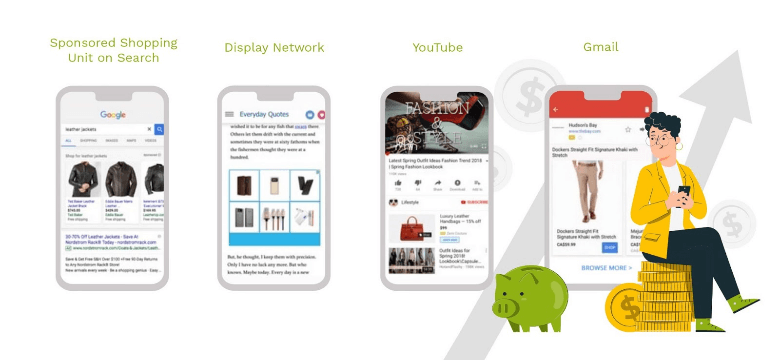
Product Page Checklist
- Product title and subtitle
- Make sure the product title is clear, descriptive, and honest enough for Google to identify the product and send relevant traffic your way (Look at Amazon for inspiration)But avoid “keyword” stuffing! Honesty and simplicity are key
- Product description
- Product descriptions are supplementary to your title
- Use this opportunity to elaborate on the specifics of your product: any particular materials, special features, ingredients that are worth highlighting but would be too long for your title
- Product media (images and videos)
- We purchase with our eyes first
- Custom imagery is always going to be better than stock photos, particularly lifestyle images that help customers picture themselves using your product
- Nested navigation
- Make sure navigation is clear, easy, and accessible—we don’t want people to get lost
- Use breadcrumbs so users can always find their way back
- Social proof (i.e. reviews)
- Customers buy from businesses they trust—Enter: reviews
- Aggregating enough reviews takes time, so ask your customers for a review after 30 days of purchasing and give them an incentive or reward for the completion
- The 30-day rule gives you at least a few days/weeks to resolve any issues—and get a good review for it.
- Once you have enough five-star reviews, you can add them to your site.
- Clear call-to-action (CTA)
- If you don’t tell people what you want them to do they won’t do it
- A clear, bold CTA nudges your customer to the next step
- Isolate the action you want them to take: make the CTA a BIG button (not just a hyperlink)
- Clear customization options
- If you offer customized products, make sure the options are clear and don’t overwhelm your customers to avoid cart abandonment
Product Media
When it comes to adding images to your website, here’s the thing:
You don’t need to be a professional photographer.
In fact, all you need to create high quality images is:
 A smartphone (new iPhones or Samsung do a really good job)
A smartphone (new iPhones or Samsung do a really good job)
 A plain white background
A plain white background
 Natural lighting
Natural lighting
Don’t zoom in.
Don’t use flash.
And edit your photos if you can (check Fiverr or pixc for outsourcing options).
That’s all it takes!

Remember, your photos should give context and further showcase details of the product. If your product has a unique feature, it’s best to explain what that feature is in the descriptions and show it in your images.
Overwhelmed by how many products you need to capture? Start with your bestsellers. Make sure each of them has a decent product photo and (if possible) a short video. 5-7 images per product should be enough.
We are visual creatures. High quality product media will close the sale.
Product Media Part Two: Lifestyle Images
Speaking of product media, lifestyle images are critical for customers to visualize your product in action.
*Remember: Lifestyle imagery is a photo or video of products being used*
Here are some tips:
 Give context
Give context
- Hey, your product doesn’t have to be the “main subject” in the photo. In fact, it could be in the background—like this poor Nespresso machine, competing with George Clooney’s eternal handsomeness:
 You can use photos from your Instagram or Pinterest
You can use photos from your Instagram or Pinterest
- Speaking of Instagram, you can send your product to influencers (for free) in exchange for promotional content on their page
- Check out imagency.com to find influencers
 Shoot a YouTube overview of the product and paste it on your product page
Shoot a YouTube overview of the product and paste it on your product page

Robust Titles and Descriptions
 Use the product description to sell the transformation
Use the product description to sell the transformation
- The description sells the TRANSFORMATION, not the product
- Use the language that your avatar uses but make sure you also include in the right keywords that Google understands
 Include specifications
Include specifications
- Size, material, weight, features
 Use the product titles and descriptions to communicate with Google
Use the product titles and descriptions to communicate with Google
- Google relies on product titles and descriptions to identify products and send relevant traffic—so, make sure they are “machine friendly” (clear and easy to understand)
 Good descriptions can be repurposed
Good descriptions can be repurposed
- Save some time and energy! Quality descriptions can be loosely reused for other product pages as well as for ad copy
Live Chat
We strongly recommend live chat on your website. Here’s why:
 Diagnose errors
Diagnose errors
- Live chat allows you to compile visitor questions and create content that answers those questions for future customers
- Add helpful information to your product pages and place them near the top of your page
*Try tawk.to*
*Check out Shopify’s app integration here https://apps.shopify.com/tawk-to*
 Identify objections
Identify objections
- Live chat can give you insight into what holds customers back from making a purchase—what questions do they ask before abandoning their cart? What concerns do they bring up in the chat?
 Improve conversion rates
Improve conversion rates
- Sometimes, all it takes is a little supportive nudge for customers to make a purchase
- By “being there” through their virtual journey, you have a higher likelihood of making a conversion
Get That Website Ready to Convert
I know, I know. I just gave you a lot of homework.
But listen up: I’ll be back with a guide on the next steps of setting up successful Google Ads campaigns—the dreaded technical and legal requirements.
But if you’re feeling extra-eager, you can check out this Google Ads Mastery Workshop.
Or, you can check out my entire step-by-step guide to Google Ads for eCommerce here.
Kasim Aslam
Kasim Aslam is the founder and CEO of Solutions 8, one of the world’s top ranked Google Ads agencies.
Recipient of the Arizona Interactive Marketing Association’s 2017 TIM Award for Person of the Year, Kasim was also named one of the Top 50 Digital Marketing Thought Leaders in the United States by The University of Missouri in 2020.
Kasim was hand-selected as the Traffic Coach for DigitalMarketer.com’s ELITE coaching program by their executive team. He is also the co-host of the long-running podcast, Perpetual Traffic.
His book, The 7 Critical Principles of Effective Digital Marketing, was featured as one of the Top 100 Digital Marketing Books of All Time by Book Authority.
Kasim helped launch the National Association of Child Helplines (NAACH) and worked with the United States Army, Intel, as well as a Gates Foundation-funded nonprofit, a 54,000 member PPO, the largest privately-owned bank in the United States, and an Academy Award-contending documentary.
He lives in Scottsdale, Arizona with his wife and two sons.
The post Google Ads for eCommerce: How to Make Your Website Conversion-Ready appeared first on DigitalMarketer.
Source: digitalmarketer.com

Do Links from Guest Posts Even Work? Here’s What We Learned from Analyzing 1,091 Sites That Accept Guest Posts.
It’s frowned upon to build links through guest posts.
If you do, they should be nofollowed and ideally you should be guest posting for brand awareness and referral traffic.
Even though that’s what I follow, it doesn’t mean others do.
Plus, I get hundreds of emails a day asking me if I accept guest posts, hence I know it’s still a popular link building method (although I ignore all those emails).
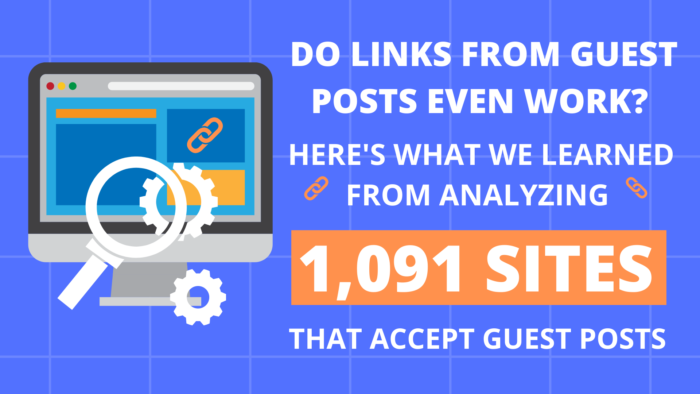
What Kind of Sites Did We Analyze?
First off, not all blogs accept guest posts. So, if a blog didn’t accept a guest post, we clearly didn’t include it in our study.
Second, we looked at sites that clearly labeled content as a guest post or as a post written by a guest author or guest contributor.
Third, we looked at sites that used dofollow links in the guest posts (even though they should have been nofollowed) to see if they had an impact on rankings.
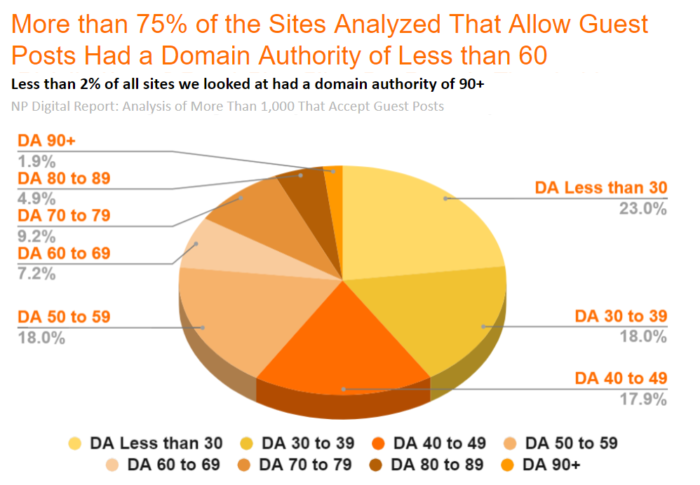
As you can see from the graph above, we looked at sites across different domain authority levels. We wanted to see what impact it had on whether a guest post received traction or not.
We also looked at sites with varied traffic ranges to see where posts might perform best.
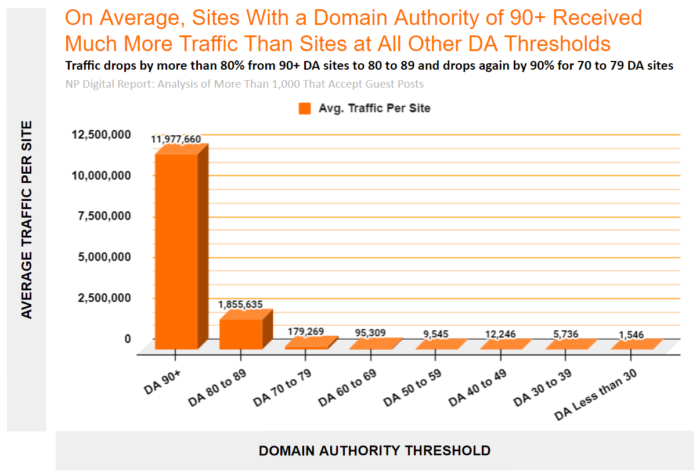
As you can see, targeting sites with a domain authority above 90 will likely lead to more traffic. At the same time, those are also the sites that will be hardest to get links from.
So, What Did We Learn?
The short answer: guest posts links kind of work and kind of don’t.

I know that isn’t a clear answer, but it is if you read the rest of the post. Because there are certain types of guest post links that work and there are others that don’t.
Here are some more insights…
Too Many External Links Is Bad
Some guest posting sites link out a lot.
Some don’t link out too much.
Although you shouldn’t be focusing on how many times you do or don’t link out, you should be focusing on providing the best user experience to your audience. If that means including a relevant link to another site in your article, by all means link out.
If it doesn’t make sense, then you shouldn’t.
Look at this chart.
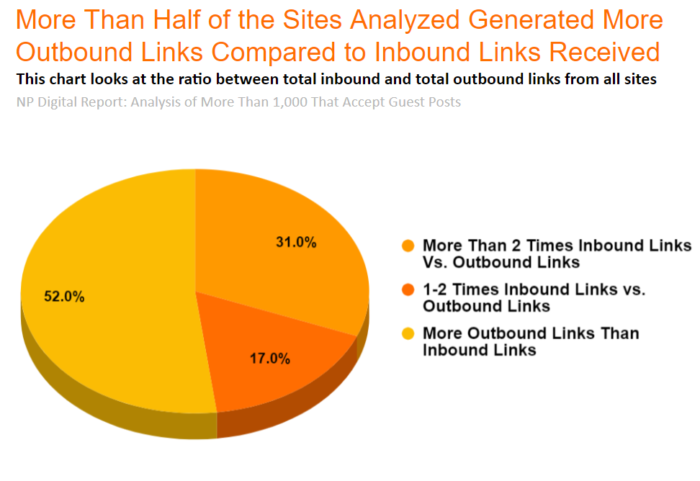
Now, it’s hard to know for sure if a link received from a guest blog site with more outbound links than inbound links is effective since websites don’t just have 1 backlink. Most websites can have hundreds and, in some cases, millions of them.
Just look at my site NeilPatel.com. Sadly some spammy websites link to me (scrapper sites) and some high authority websites link to me. It’s hard to know for sure what the impact a spammy site link has on my rankings compared to the ones received from high domain authority sites.
Instead, what we could do is look at the number of keywords a guest posting site ranks for. In theory, the more keywords a site ranks for, the better they are since they are liked by Google. I would think that a link from them would be more favorable.
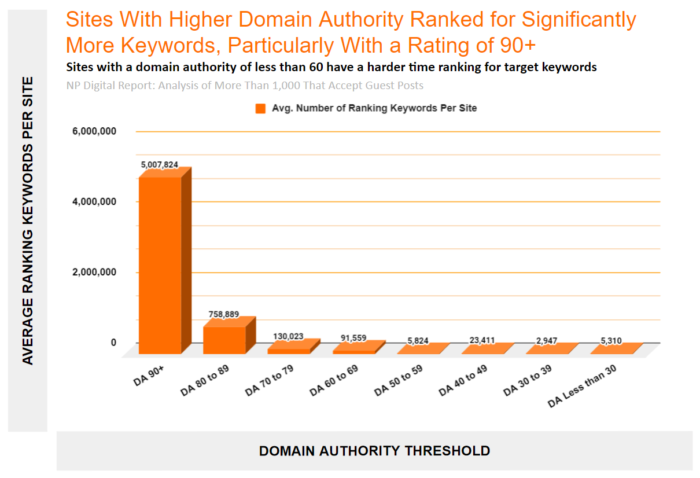
What you’ll notice is, generally speaking, the higher domain authority a site has, the more keywords it ranks for. But we already knew that.
When looking at the domain authority range from 0 to 59, you’ll notice that there isn’t a consistent upward trend. That’s because many of the domains from our analysis in this range tended to be sites that were expired or bought-out and are mainly used for guest posting purposes.
Even more interesting. The guest posting sites that had more external links than inbound links all had a domain authority of less than 60.
From this one insight, someone could infer that you should aim to get links from sites who have more inbound links than external links. As in, sites that have higher domain authority.
You should also avoid guest posting sites that exist for the sole purpose of linking out to other sites. These can be considered spam links.
The Right Links Help
From all of the guest posting sites we analyzed, we found 14 businesses who were exclusively receiving links from some of the sites we looked at. From these 14 businesses, six of them only received links from guest posting sites with a domain authority of less than 60.
In other words, they didn’t have links from any other sites.
So, we dove into their rankings and traffic.
What’s funny is that these six businesses had little to no rankings or traffic.
Let’s look at the number of page 1 Google rankings they had.
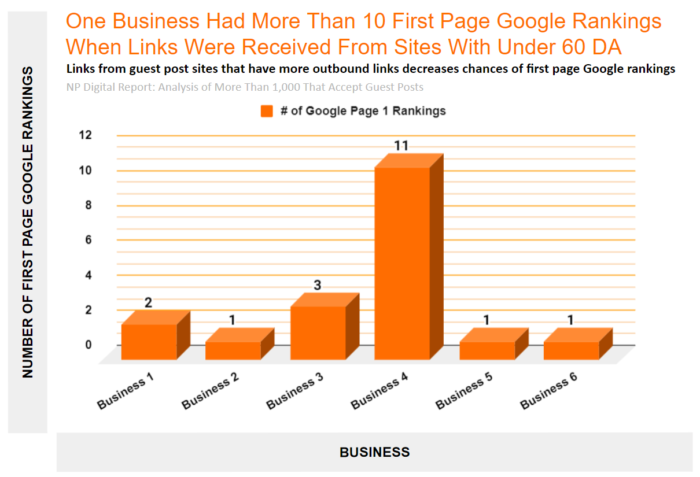
Since these six businesses only received links from spammy guest posting sites, we know that each of those sites had more outbound than inbound links. It’s clear that those sites didn’t really serve a purpose other than for guest posting.
The remaining 8 businesses we looked at also had links from spammy guest posting sites but also received links from more legitimate sources too. As in, guest posting sites that had more inbound links than outbound links.
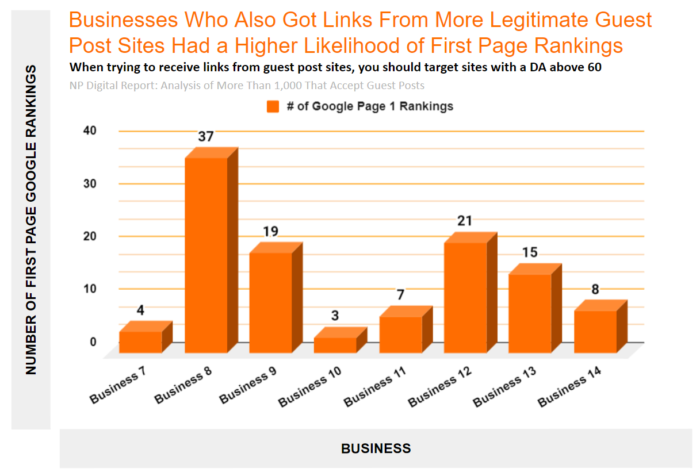
The businesses that built links from the spammy guest posting sites had, on average, 3.16 page 1 rankings on Google. On the other hand, businesses that also built links from the higher quality guest posting sites as well had, on average, 14.25 page 1 rankings on Google.
Keep in mind some industries are easier to rank for than others and some keywords drive less traffic than others, so not all page 1 rankings are created equal.
At the same time, this trend shows that if you target links from higher quality guest post sites, there is a better chance of ranking on the first page.
Conclusion: Do Links From Guest Posts Work?
When I originally said guest posting links can or can’t help it’s because the quality of the link really matters.
When you get links from spammy sites, as in sites whose sole purpose is to link out and don’t get as many links coming in, search engines know this. If this is a practice you have been doing, don’t expect your rankings to go up as much.
On the flip side, if you generate links from higher quality guest post sites, you are going to be much better off.
The goal of this post was to figure out if links from guest posts really help and now we know the answer. However, if you’re going to build links from guest posts than they should be nofollowed and you should be doing it primarily for branding and referral traffic purposes.
Source: neilpatel.com
![Essential SMS and Email Tips: 5 Strategies You Can Implement Now [Free Webinar on February 15th]](https://focusintoprofits.com/wp-content/uploads/2022/02/1644550509.png)
Essential SMS and Email Tips: 5 Strategies You Can Implement Now [Free Webinar on February 15th]
How important are SMS and email for a company’s success in 2022? Very.
78 percent of marketers say email is an important part of a company’s success.
And texting is quickly becoming another way for businesses to succeed. In fact, a 2021 survey found the majority of marketers reported increased revenue from SMS efforts.
If you are looking for new and innovative ways to engage your customers, adapting custom email and SMS strategies might be the solution you need to grow subscriber lists and improve the customer experience.
Join us on Tuesday, February 15th at 8 am PST for a FREE webinar on 5 No-Brainer SMS and Email Marketing Strategies You Should Implement Today!
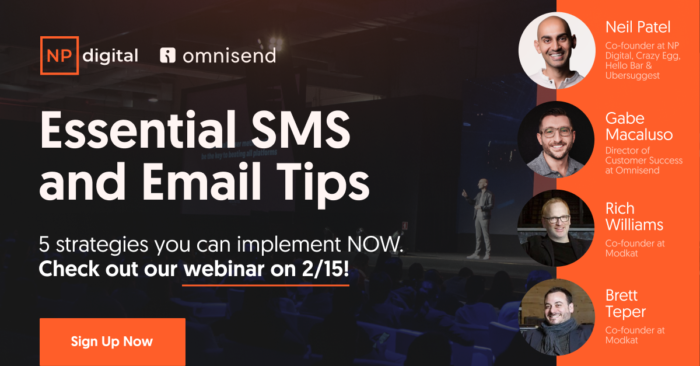
Why Having an SMS and Email Strategy is Important?
By 2024, an estimated 4.5 billion people will use email. When done correctly, email marketing can increase traffic to your website, conversions, and revenue.
What do we mean by “correctly?” We mean following trends, using the latest tools, and relying on data to optimize your emails for opens and conversions.
SMS is also becoming a more effective communication channel. Texts can be used for marketing, to increase revenue, or even to offer quick customer service. In fact, close to 60 percent of consumers check their text messages within 1-5 minutes so they are a great way to get people’s attention.
The click-through rate of SMS is also very high at 19.3 percent, better than email which has a CTR of 4.2 percent, or Facebook ads, which have a 0.05 percent CTR.
You may be wondering how can you get such a high click-through rate with SMS as well, turning those opens into conversions and revenue? Attend our webinar to find out!
Who Will Benefit from Attending the Webinar?
Marketers who want to learn insider tips so they can expand their email and SMS skills.Small business owners who want help launching or improving their email and SMS efforts.Blog writers who want to grow their subscriber list.Anyone who wants to improve their SMS or email click-through and conversion rates.
What Businesses Do Will Benefit from New Email and SMS Tips?
Marketers, small businesses, e-commerce companies, and B2B organizations alike will all benefit from this webinar. Need proof?
- 81 percent of B2B marketers say email is the most important part of their content marketing efforts.
- Eight out of ten B2C customers open their welcome emails.
- And, finally, a survey by Campaign Monitor found 64 percent of small businesses use email to reach their customers.
SMS is becoming just as important for all these business models. How it is used ranges from appointment confirmations to sales promotions, to customer service, and everything in between. In case you need more convincing:
About 33 percent of marketers expect to prioritize mobile loyalty programs over the next year.85 percent of customers say they prefer receiving text messages over a phone call or email.64 percent of consumers think that companies who text value their time and are more progressive.
The email and SMS strategies covered in this webinar can be applied to any business model.
What You’ll Learn in This Webinar
In this webinar, we’ll first go over some of the top email and SMS trends we see coming in 2022. We will explain what each of them means as well as the impact they can have on you and your business.
Next, we’ll provide five detailed email and SMS tips. For each tip, we’ll discuss why we think it could be a game-changer for your business in 2022 and also provide some examples of how each can be used.
Finally, we’ll walk you through some step-by-step processes you can take to implement each tip and start seeing results right away.
By following the tips you will learn in this webinar, you’ll be in a prime position to grow your subscriber list, create a cohesive email and SMS strategy, and get more conversions from each communication you send. We look forward to seeing you on February 15th!
Source: neilpatel.com


